The diverse landscape of South Texas is home to a vast array of bird species that showcase the region’s unique blend of subtropical and arid climates. With over 500 bird species identified in the state, Texas has become a prime destination for bird watchers and enthusiasts from all over the world.
The crossroads of the Americas serves as a critical stopover for migrating birds, making South Texas a central hub for bird conservation and research.
From majestic raptors and waterfowl to vibrant tropical species, South Texas offers a diverse birding experience that is hard to match.
In this article, we will explore some of the bird species that can be found in the region and the efforts of conservationists to protect these precious creatures.
1. Greater Roadrunner
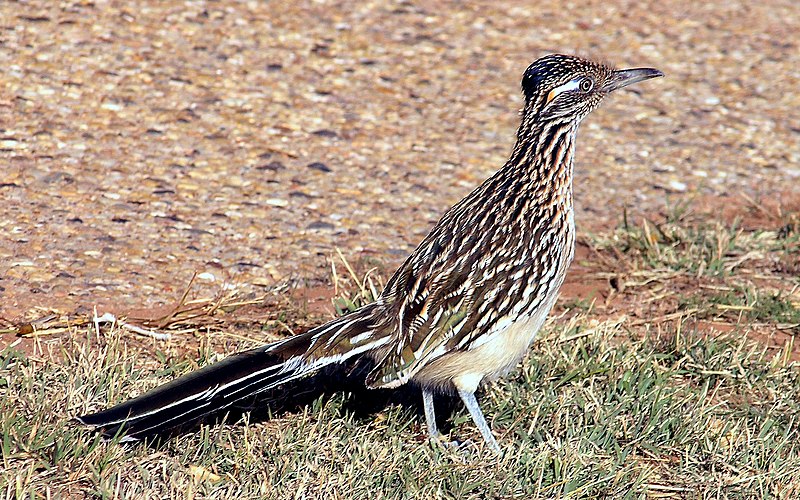
The Greater Roadrunner is a long-legged bird in the Cuculidae family that can be found throughout Aridoamerica. It has many nicknames, including Californian Earth-cuckoo, Chaparral Cock and Snake Killer.
This species is one of two birds belonging to the genus Geococcyx – the other being its smaller counterpart, Lesser Roadrunner.
The Greater Roadrunners are known to eat anything they can catch such as lizards, snakes and insects, making them very valuable predators for keeping pests at bay.
They also have an impressive burst of speed over short distances which helps with hunting prey or escaping danger quickly.
With their large eyes and distinctive black tip on their tail feathers, these amazing creatures make quite an impression when spotted out in nature.Scientific classification:
| Kingdom | Animalia |
| Phylum | Chordata |
| Class | Aves |
| Order | Cuculiformes |
| Family | Cuculidae |
| Genus | Geococcyx |
| Species | G. californianus |
Also Featured In: Most Common United States Birds, Birds that Live in Chaparral
2. American White Pelican
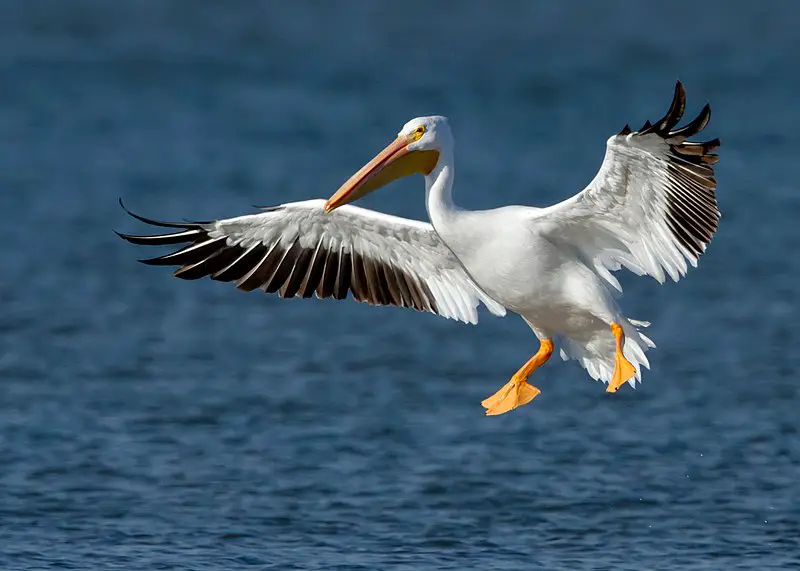
The American White Pelican is a majestic bird from the Pelecaniformes order, known for its impressive size and ability to soar gracefully in the sky.
It breeds during summer months in North America and migrates southwards towards Central and South America during winter.
The species was first described by German naturalist Johann Friedrich Gmelin back in 1789 as part of his updated version of Carl Linnaeus’ work.
This large aquatic bird has an all-white plumage with black primary flight feathers on its wings, while its beak features a characteristic yellowish colouration at the base near the face.
Its diet mainly consists of fish which it typically catches after dipping into water using its long bill; yet sometimes they can be seen stealing food items from other birds such as cormorants or gulls.Scientific classification:
| Kingdom | Animalia |
| Phylum | Chordata |
| Class | Aves |
| Order | Pelecaniformes |
| Family | Pelecanidae |
| Genus | Pelecanus |
| Species | P. erythrorhynchos |
Also Featured In: Most Popular Bird Species in North America, Birds that Live around Central Florida
3. Killdeer
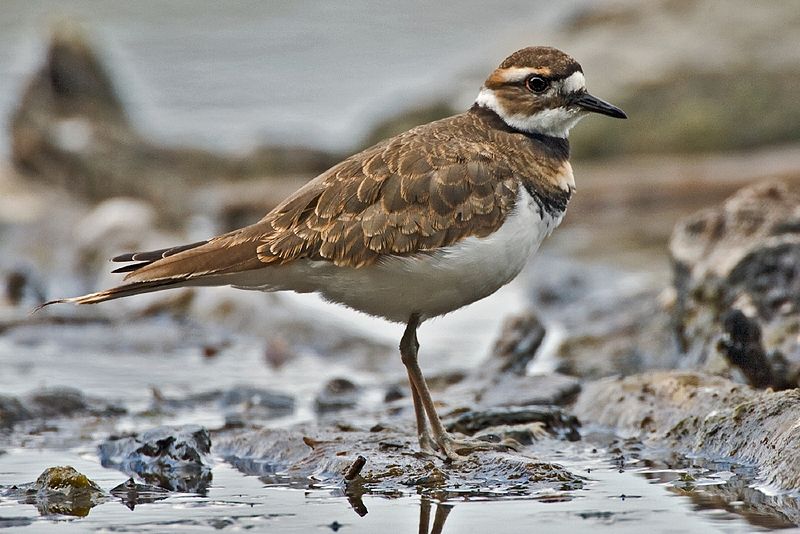
The Killdeer bird is a large plover found in the Americas. It has an unmistakable call which gives it its name, and boasts striking upperparts of brown with rufous fringes.
Its head features patches of white and black, while two distinctive bands adorn its neck – one black above, and one chestnut below.
The undersides are mostly white or pale buff-brown; their wings feature bright orange stripes when they take flight.
During breeding season males perform elaborate courtship rituals to attract females into establishing a pair bond; they also defend territories fiercely against other birds that encroach on them during this time.
In winter months some killdeers migrate southwards but many stay put throughout the cold weather too.
All in all these beautiful creatures provide us with quite a sight indeed.Scientific classification:
| Kingdom | Animalia |
| Phylum | Chordata |
| Class | Aves |
| Order | Charadriiformes |
| Family | Charadriidae |
| Genus | Charadrius |
| Species | C. vociferus |
Also Featured In: Most Common Lake Birds, Birds that Live in San Francisco Bay Area
4. Aplomado Falcon
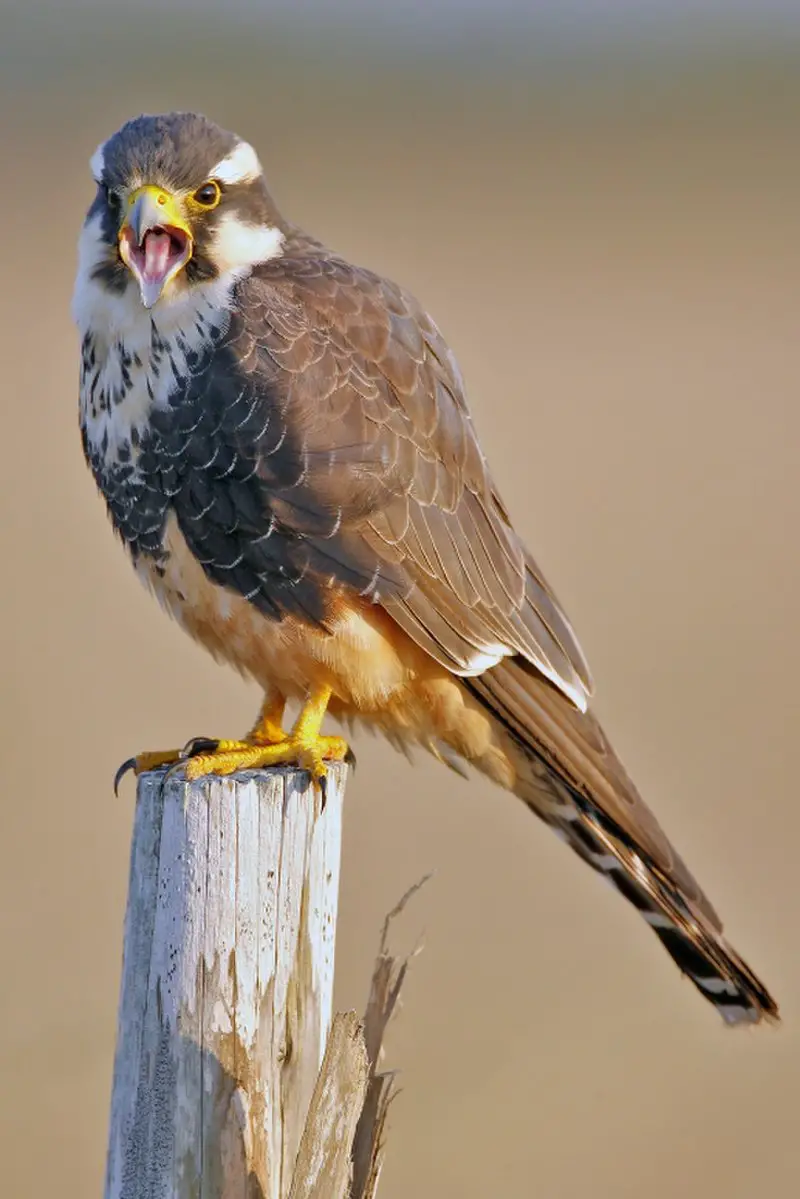
The Aplomado Falcon is a medium-sized raptor that can be found in the Americas. It has a beautiful slate grey and white plumage, with dark barring on its wings and tail.
Its long pointed wings make it an agile hunter of small birds and rodents, which it captures by flying quickly at low altitudes or swooping down from high perches.
The species’ largest range extends through South America but not into the deep Amazon Basin regions.
This falcon is sometimes mistaken for the Hobby due to their similar shape; however, they are two distinct species with different hunting behaviours and diets.Scientific classification:
| Kingdom | Animalia |
| Phylum | Chordata |
| Class | Aves |
| Order | Falconiformes |
| Family | Falconidae |
| Genus | Falco |
| Species | F. femoralis |
Also Featured In: Birds that Live in Guyana,
5. White-Winged Dove
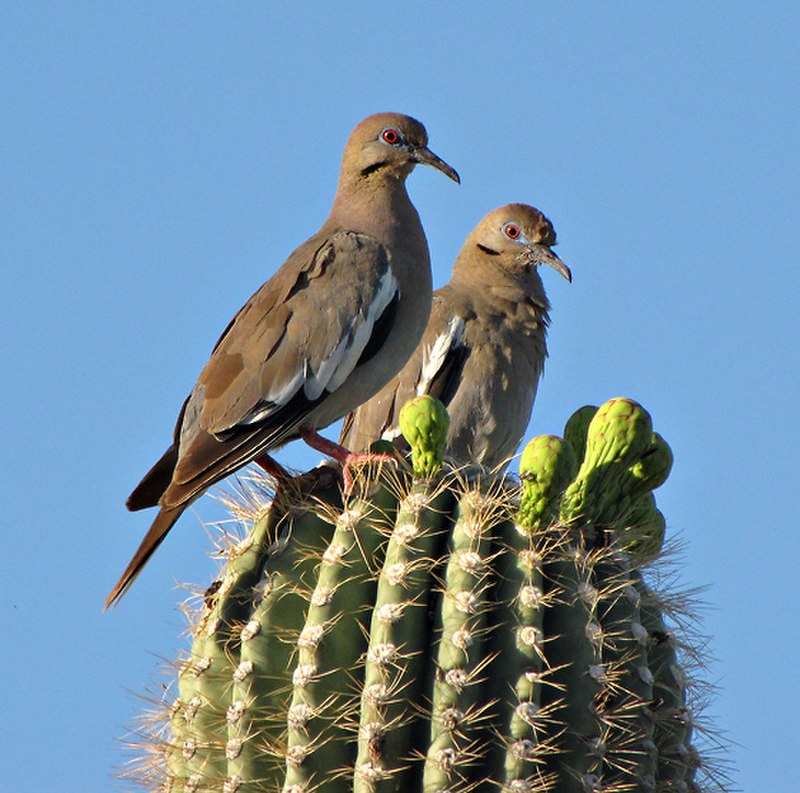
The White-winged Dove is an impressive bird with a large body and wingspan. Its distinctive feature is the white edge on its wings, which makes it easily recognizable when in flight.
It has blue eyerings, red eyes and gray plumage, while juveniles are duller in coloration than adults.
This dove species inhabits areas from Southwestern United States through Mexico to Central America as well as Caribbean islands.
They usually live close to human settlements or cities but can also be found in agricultural fields feeding on grains like corn or wheat seeds left by farmers after harvest season ends.
In their natural habitat they feed primarily on insects, fruits and small plants such as certain cacti species.Scientific classification:
| Kingdom | Animalia |
| Phylum | Chordata |
| Class | Aves |
| Order | Columbiformes |
| Family | Columbidae |
| Genus | Zenaida |
| Species | Z. asiatica |
Also Featured In: Top Birds Found in Mexico, Common Birds of Houston
6. Inca Dove
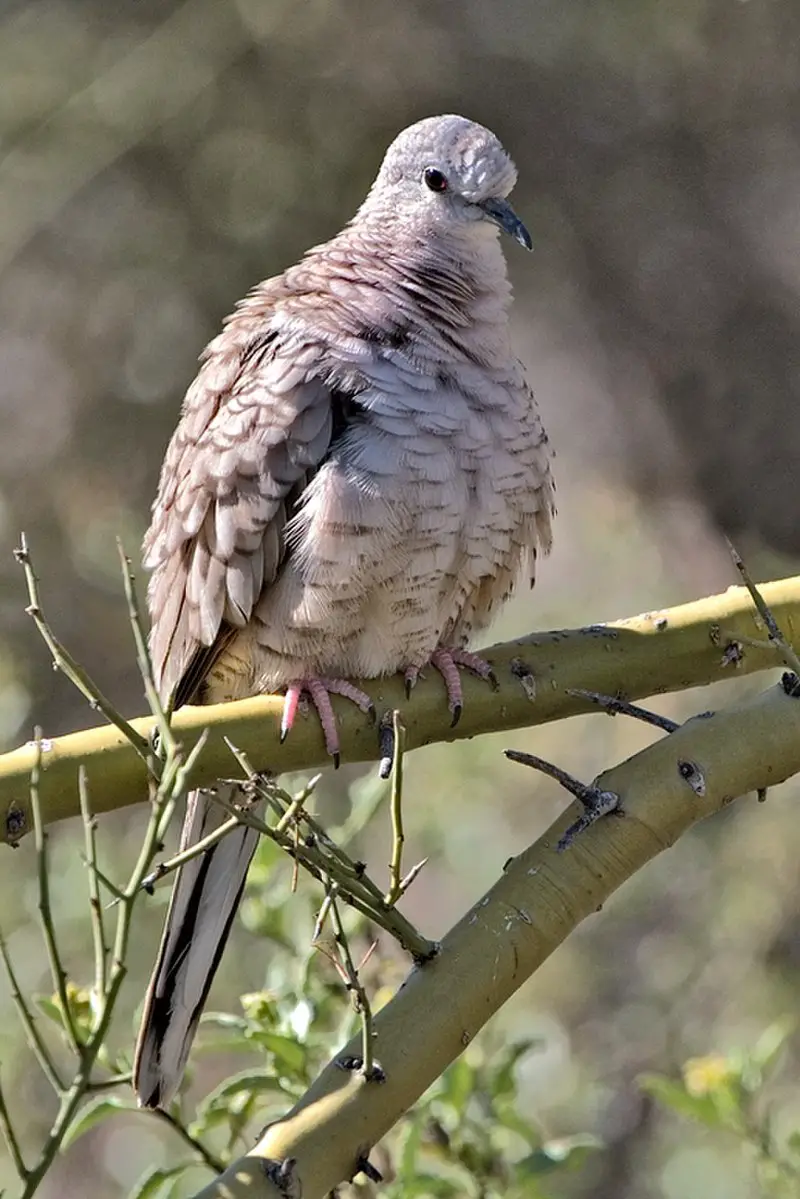
The Inca Dove is a small, slender bird found in the New World. It has an average length of 16.5–23 cm and weighs about 30-58 gm. Its wingspan measures around 28.5cm but can reach up to 32cm at max.
The body of this dove is grayish brown with feathers that are rounded off tips giving it a soft look overall.
This species was first described by French surgeon and naturalist René Lesson back in 1847 and since then have been living happily all over North America from Mexico through Texas to South Dakota, Kansas as well as parts of Arizona among others regions too.Scientific classification:
| Kingdom | Animalia |
| Phylum | Chordata |
| Class | Aves |
| Order | Columbiformes |
| Family | Columbidae |
| Genus | Columbina |
| Species | C. inca |
Also Featured In: Birds You’ll Find in Sonoran, Birds that Live in Jalisco Birds
7. American White Ibis
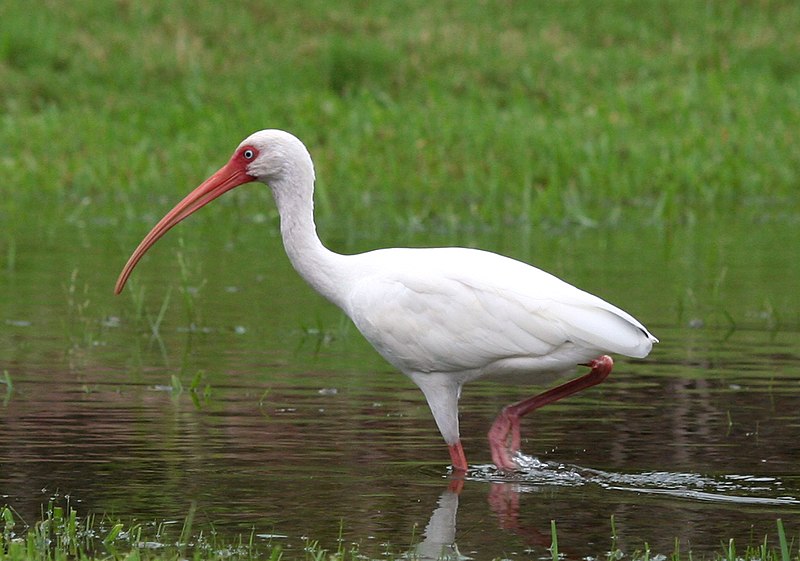
The American white ibis is a medium-sized bird with an overall white plumage and long legs. It has a bright red-orange downward curved bill, and black wing tips that are usually only visible in flight.
This species of ibis can be found from Virginia south through most of the coastal New World tropics.
They have been known to inhabit marshes, swamps, ponds, lakeshores as well as mangrove forests near water sources where they feed on crustaceans such as crabs and shrimp among other aquatic animals like insects or snails.
The American white ibis plays an important role in its ecosystem by helping to control insect populations which helps maintain balance within these environments.Scientific classification:
| Kingdom | Animalia |
| Phylum | Chordata |
| Class | Aves |
| Order | Pelecaniformes |
| Family | Threskiornithidae |
| Genus | Eudocimus |
| Species | E. albus |
Also Featured In: Everglades Birds, Swamps Birds You Should Know
8. Reddish Egret
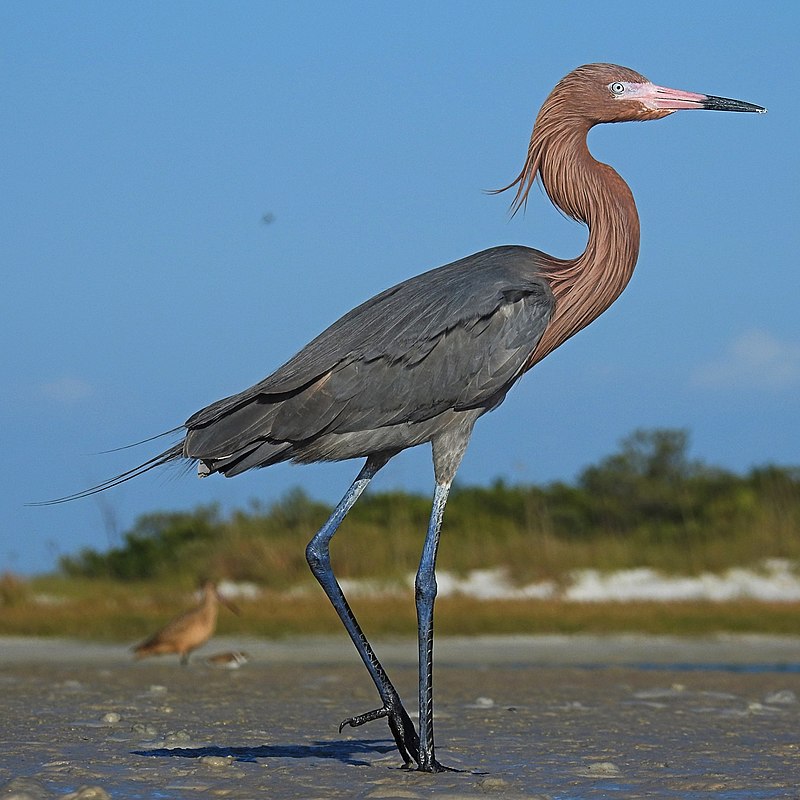
The Reddish Egret is a medium-sized heron that breeds in Central America, The Bahamas, the Caribbean, Texas and Mexico.
It prefers mud flats as its habitat of choice due to its unique foraging behaviour which differs from other herons.
In the past it was hunted widely for its feathers used to make fashionable hats but thankfully this practice has now been stopped.
They have white or grey plumage with pink legs and bill giving them their name.
These birds feed mainly on fish which they catch by making quick darting movements in shallow water or running rapidly through shallows stirring up prey so they can snatch them easily with their bills.
Their long wings enable them to fly quickly when hunting and also during migration season when many travel southwards towards warmer climates.Scientific classification:
| Kingdom | Animalia |
| Phylum | Chordata |
| Class | Aves |
| Order | Pelecaniformes |
| Family | Ardeidae |
| Genus | Egretta |
| Species | E. rufescens |
Also Featured In: Birds that Live around Southwest Florida, Most Common Oaxaca Birds
9. Ringed Kingfisher
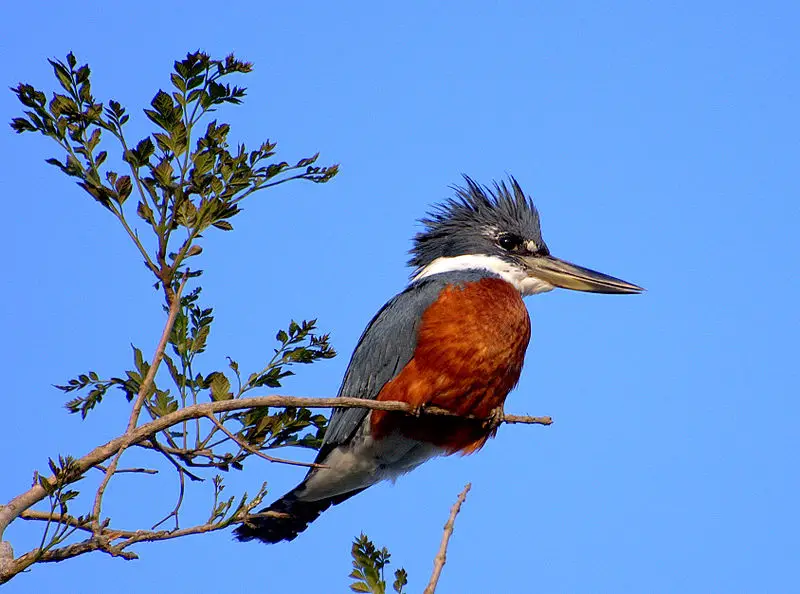
The Ringed Kingfisher is a large, vibrant bird that can be easily noticed by its loud call. It’s found in tropical regions from the lower Rio Grande Valley of southeastern Texas to Central America and even as far south as Tierra del Fuego.
This ground-dwelling species prefers to inhabit open areas near water bodies like streams, rivers and lakes which provide them with plenty of food such as fish, amphibians, crustaceans and insects.
In 1888 it was first identified by ornithologist Frank Chapman who noted its distinct ring pattern on the breast area.
The upperparts are dark blue while underneath they have white spots around their neck and belly region along with pale brown wings tipped in black stripes making this species quite unique among other kingfishers.
They may look intimidating but these birds actually play an important role for humans since they help control insect populations thus helping maintain a healthy balance within our ecosystems.Scientific classification:
| Kingdom | Animalia |
| Phylum | Chordata |
| Class | Aves |
| Order | Coraciiformes |
| Family | Alcedinidae |
| Subfamily | Cerylinae |
| Genus | Megaceryle |
| Species | M. torquata |
Also Featured In: Common Birds in Colombia, Red Birds You’ll Commonly Found in Texas
10. Great Blue Heron

The Great Blue Heron is a majestic wading bird found in many parts of North America, Central America, the Caribbean and even as far away as the Galapagos Islands.
It has an impressive wingspan which can reach up to six feet wide. Its feathers are mainly bluish-gray with brownish streaks on both its neck and chest while its head displays white plumes.
The adult herons can also be identified by their yellow bill and legs.
They live near bodies of water such as lakes, marshes or rivers where they feed on fish using a spear like motion with their sharp bills.
An all-white population exists only in south Florida and the Florida Keys making it quite unique.Scientific classification:
| Kingdom | Animalia |
| Phylum | Chordata |
| Class | Aves |
| Order | Pelecaniformes |
| Family | Ardeidae |
| Genus | Ardea |
| Species | A. herodias |
Also Featured In: Common Birds in Canada, Water Birds Live around Us
11. Black Skimmer
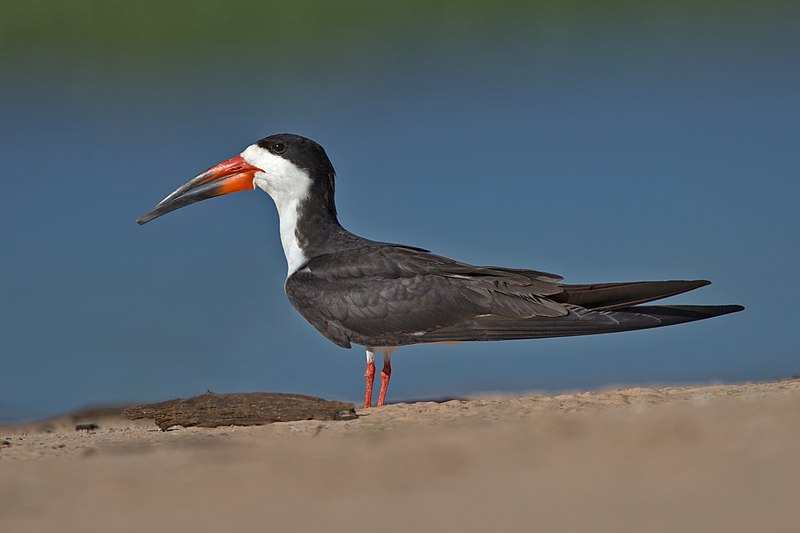
The Black Skimmer is a seabird which belongs to the skimmer genus Rynchops and Laridae family.
It breeds in North and South America, while Northern populations migrate south for winter towards warmer climates such as the Caribbean or Pacific coasts.
The Southern American races have adapted to annual floods by making shorter migrations during this time.
These birds are easily identified with their unique long red bill that has an upper mandible longer than its lower mandible.
They feed mainly on small fish caught at night when they skim across shallow water using their beak like a knife cutting through waves of water.
Their dark grey back contrasts against white belly feathers creating beautiful patterns in flight, aiding them in catching prey easier due to its camoflauge effect above and below waters surface.Scientific classification:
| Kingdom | Animalia |
| Phylum | Chordata |
| Class | Aves |
| Order | Charadriiformes |
| Family | Laridae |
| Genus | Rynchops |
| Species | R. niger |
Also Featured In: Most Unique Birds in Peru, Birds You’ll Find in the Sea
12. Groove-Billed Ani
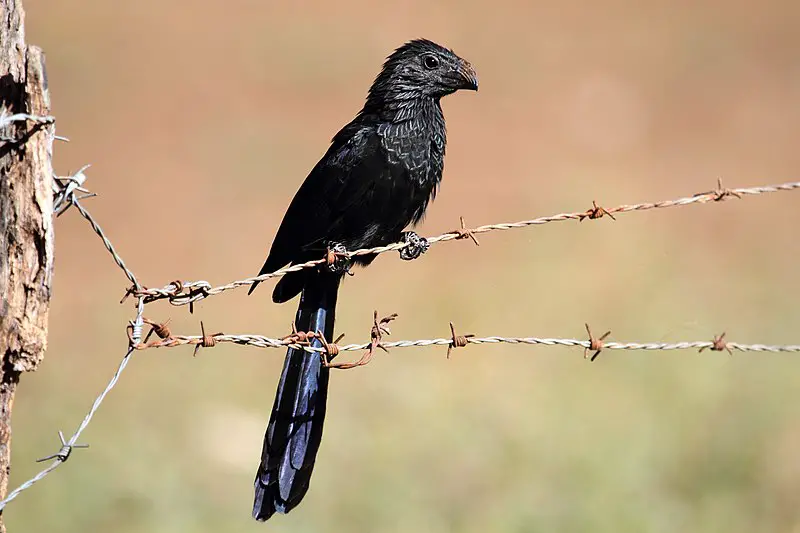
The Groove-billed ani is a tropical bird belonging to the cuckoo family. It has a long tail and large, curved beak.
This species can be found in many parts of Central America, from southern Texas to northern Colombia and Venezuela, as well as coastal Ecuador and Peru.
In some places it may retreat during colder months but overall they are considered resident birds throughout their range.
They prefer open woodlands near water sources like mangroves or swamps where there plenty of insects for them to feed on such as grasshoppers and beetles.
The beautiful coloration of this species ranges from blackish brown with orange spots on its wings that give way to bright blue feathers at the end of its tail making it quite striking.Scientific classification:
| Kingdom | Animalia |
| Phylum | Chordata |
| Class | Aves |
| Order | Cuculiformes |
| Family | Cuculidae |
| Genus | Crotophaga |
| Species | C. sulcirostris |
Also Featured In: Most Common Birds Found in Nayarit, Birds that Live in Morelos
13. Green Kingfisher
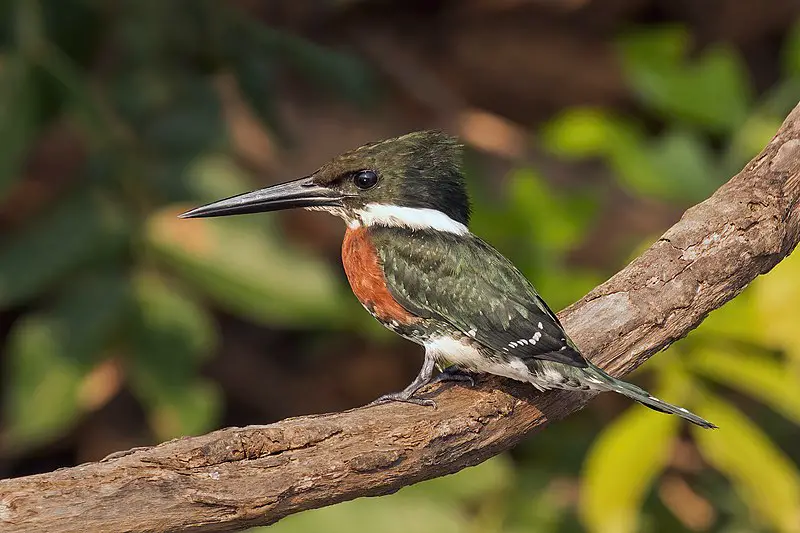
The Green Kingfisher is an incredibly vibrant bird, boasting a bright green plumage and long beak.
It can primarily be found throughout Central America, in most South American countries except Chile, as well as Texas in the United States and Trinidad & Tobago.
This species of water kingfisher belongs to subfamily Cerylinaeof family Alcedinidae which was first described by German naturalist Johann Friedrich Gmeiner back in 1788.
The Green Kingfishers are known for their active hunting habits where they perch above shallow waters looking out for prey such as small fish or crustaceans before diving down rapidly into the water with a loud splash.Scientific classification:
| Kingdom | Animalia |
| Phylum | Chordata |
| Class | Aves |
| Order | Coraciiformes |
| Family | Alcedinidae |
| Subfamily | Cerylinae |
| Genus | Chloroceryle |
| Species | C. americana |
Also Featured In: Most Common Birds Found in Chile, Green Birds in That Live in Texas
14. Buff-Bellied Hummingbird
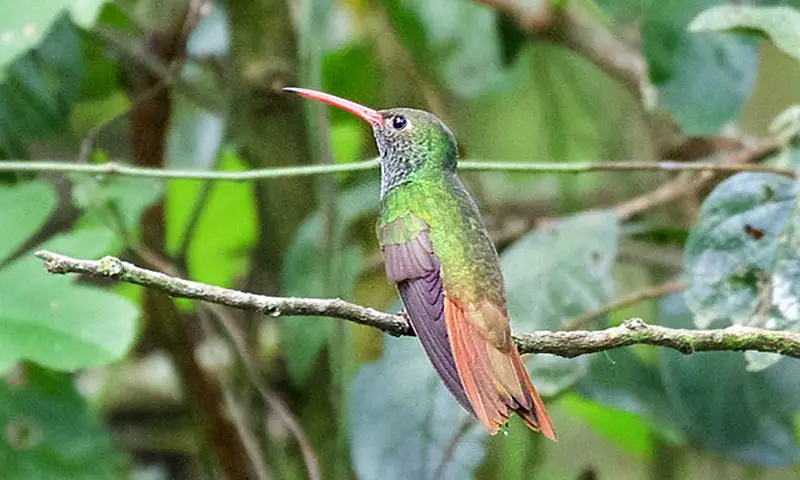
The Buff-bellied Hummingbird is a species of hummingbird belonging to the Trochilini tribe and found in Central America and parts of the United States.
It has three subspecies: A. y. yucatanensis, A. y chalconota, and A.y cerviniventris whose length ranges from 3.9 – 4 inches (10 – 11 cm).
The buff-bellied hummingbird’s plumage is mainly grey with greenish reflections on its back while it sports a distinctive buff colored belly which gives this species its name.
Its diet consists mostly of nectar as well as small insects; they often feed upon flowers near rivers or other bodies of water where their preferred food sources are plentiful.
In addition to being quite beautiful birds, these delightful creatures also possess an impressive ability for hovering flight making them one of nature’s most graceful avian wonders.Scientific classification:
| Kingdom | Animalia |
| Phylum | Chordata |
| Class | Aves |
| Order | Apodiformes |
| Family | Trochilidae |
| Genus | Amazilia |
| Species | A. yucatanensis |
Also Featured In: Most Beautiful Birds in Guatemala, Small Birds of Texas
15. Eastern Meadowlark
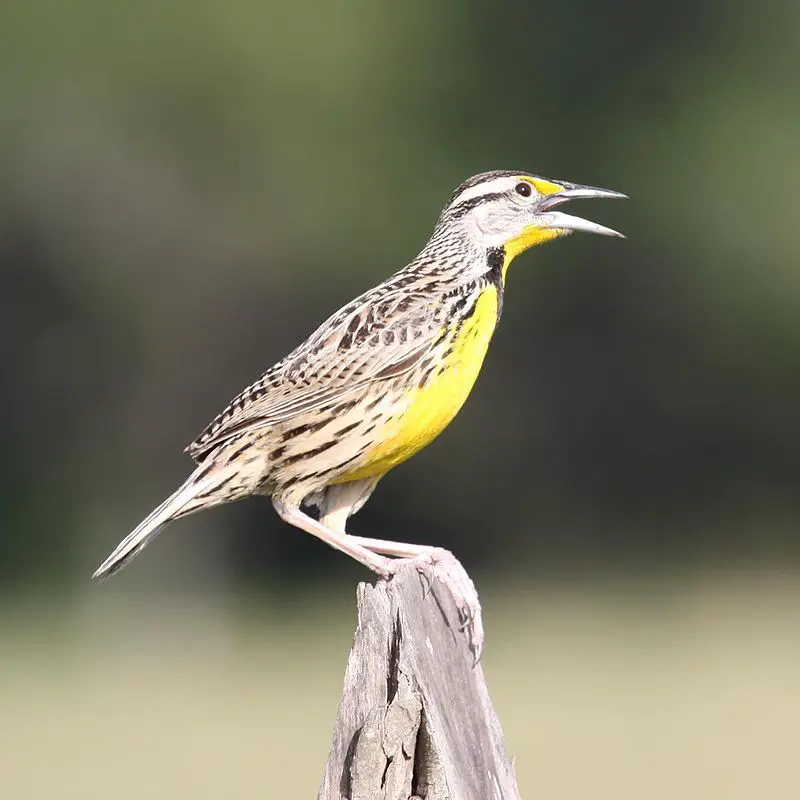
The Eastern meadowlark is a medium-sized blackbird, found from eastern North America to northern South America.
It used to be considered the same species as the Western meadowlark but has since been separated into its own distinct species.
The bird is mainly brown with yellow underparts and an orange patch on its throat; it also has white wing bars which can be seen in flight.
Its song consists of a series of musical whistles followed by gurgling notes at the end, earning them their nickname “rainmaker” birds because they are believed to bring rain if heard singing during dry weather.
These beautiful birds feed mostly on insects, seeds and other plant material while nesting amongst grasses or low shrubs near open fields where there’s plenty of food available for them.Scientific classification:
| Kingdom | Animalia |
| Phylum | Chordata |
| Class | Aves |
| Order | Passeriformes |
| Family | Icteridae |
| Genus | Sturnella |
| Species | S. magna |
Also Featured In: Most Common Types of Birds Found in Cuba, Yellow Connecticut Birds
16. Great Kiskadee
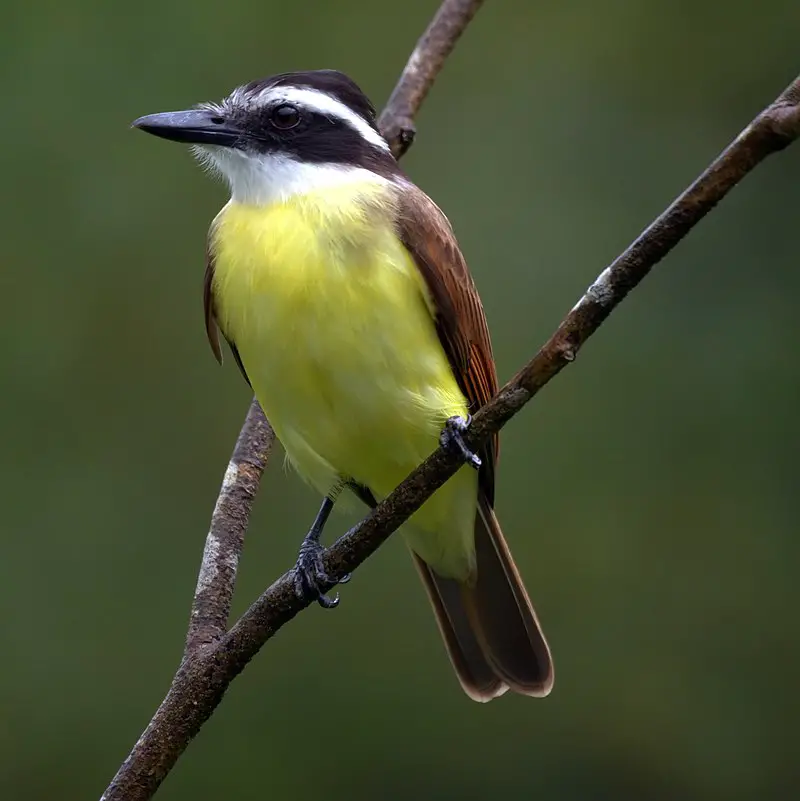
The Great Kiskadee is a passerine bird belonging to the Tyrant Flycatcher family.
It has an unmistakable yellow and black plumage, making it easily recognizable in its native habitats of Belize, Texas, Argentina and Brazil where it is known as Bem-te-vi or Benteveo respectively.
The species inhabits open woodland with some tall trees such as cultivation areas and other places surrounding human dwellings.
This adaptable bird feeds mainly on insects but also consumes fruit for energy when needed.
Its call resembles laughter which adds to its charm among avid nature watchers who are always delighted by their presence.
A unique feature that sets this species apart from others is that they can imitate songs of other birds accurately too.Scientific classification:
| Kingdom | Animalia |
| Phylum | Chordata |
| Class | Aves |
| Order | Passeriformes |
| Family | Tyrannidae |
| Genus | Pitangus Swainson, 1827 |
| Species | P. sulphuratus |
Also Featured In: Most Common Birds In Paraguay, Most Common Birds in South America Birds
17. Pauraque
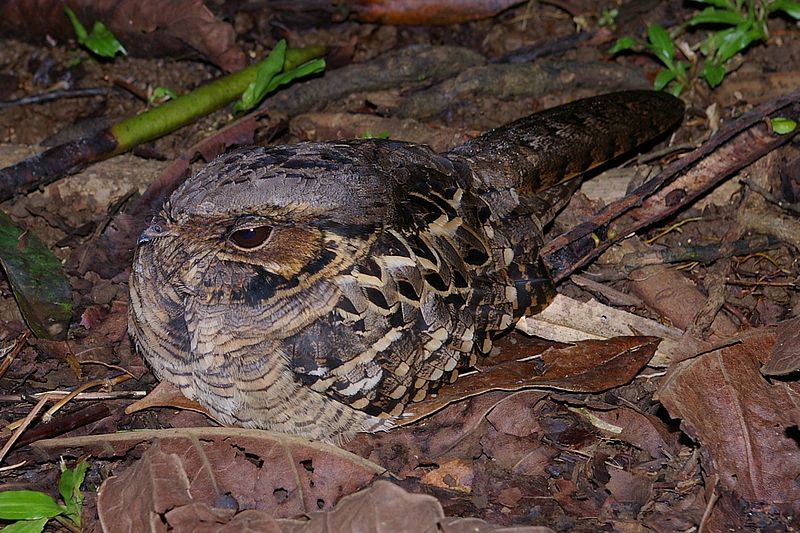
The Pauraque is a nightjar species belonging to the genus Nyctidromus and found in subtropical and tropical regions of the New World. It was formally described by German naturalist Johann in 1789.
Possessing unique features such as distinct white patches on its neck, it has adapted well to living near human settlements; making no noise during day time while roosting among tree branches or low shrubs in open areas with sparse vegetation like pastures, savannahs etc.,
The Pauraque feeds mainly on insects which helps reduce pest populations around agricultural fields.
This bird also plays an important role in maintaining healthy ecosystems across its range due to their habitat preferences for different stages of forest succession, from secondary growth forests to grasslands and scrublands.Scientific classification:
| Kingdom | Animalia |
| Phylum | Chordata |
| Class | Aves |
| Order | Caprimulgiformes |
| Family | Caprimulgidae |
| Genus | Nyctidromus |
| Species | N. albicollis |
Also Featured In: Colorful Birds of Nicaragua, Rainforest Birds You Should Know
18. Black-Bellied Whistling Duck
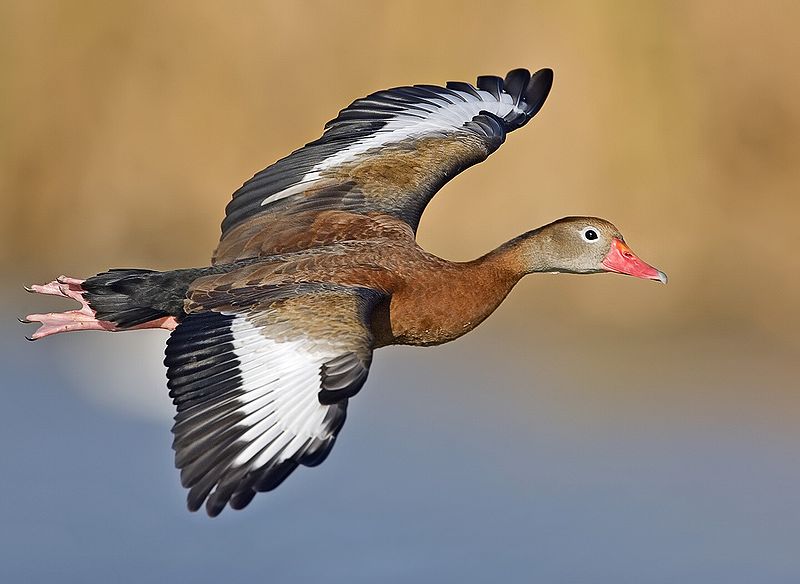
The Black-bellied whistling duck is a unique species of bird that can be found in the southern United States, Mexico, Central and South America. This small waterfowl has distinct black plumage on its belly which gives it its name.
Its call is also distinctive as it makes high pitched whistles to communicate with other members of its flock.
It prefers wetland habitats such as marshes, ponds and lakes where they feed on seeds and aquatic plants like wild rice or pondweed.
During breeding season these birds form monogamous pairs nesting in trees near bodies of water.
They are migratory birds but some may remain year round depending upon local climate conditions making them relatively common sights in certain areas during winter months when most other ducks have migrated further south for warmer weather.Scientific classification:
| Kingdom | Animalia |
| Phylum | Chordata |
| Class | Aves |
| Order | Anseriformes |
| Family | Anatidae |
| Genus | Dendrocygna |
| Species | D. autumnalis |
Also Featured In: El Salvador Birds, Common San Antonio Birds
19. Golden-Fronted Woodpecker
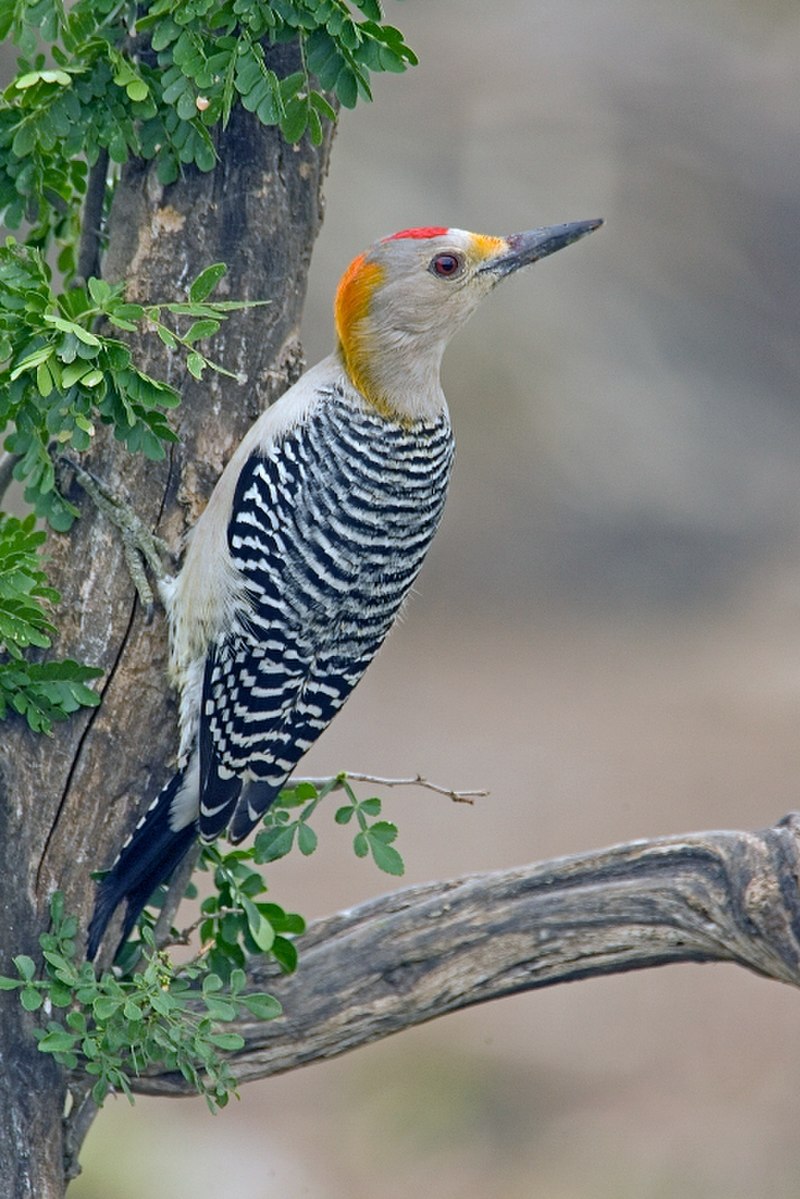
The golden-fronted woodpecker is an attractive species that inhabits mesquite, riparian woodlands and tropical rainforests across the southern United States, Mexico, Belize Guatemala El Salvador Honduras and northern Nicaragua.
It has a unique appearance with its yellow forehead patch contrasting against its grey back feathers.
These birds eat insects as well as fruits of many trees including cactus fruit in some areas.
They are known to make nests in cavities they excavate from dead or dying trees or utility poles which helps disperse essential nutrients into the ecosystem.
Their loud calls can be heard during breeding season providing bird watchers with a memorable experience.Scientific classification:
| Kingdom | Animalia |
| Phylum | Chordata |
| Class | Aves |
| Order | Piciformes |
| Family | Picidae |
| Genus | Melanerpes |
| Species | M. aurifrons |
Also Featured In: Native Birds in Lower Rio Grande Valley, Belly Birds of Texas You Need to See
20. Altamira Oriole

The Altamira oriole is a New World species found in subtropical lowlands from the Mexican Gulf Coast to northern Central America, and inland as well. It was only recently spotted in southern Texas since 1939.
This bird stands out among its genus for being the largest at 25cm (9.8in) and 56g (2oz). Its preferred habitat is open woodland where it builds nests made of plant fibers and animal hair lined with grasses or mosses.
Adults have black heads, wings and tails while their chests are orange-yellow with white markings on each side; juveniles display more yellowish plumage than adults do.
They feed mainly on insects but also occasionally eat fruits or nectar depending on what’s available during certain seasonsScientific classification:
| Kingdom | Animalia |
| Phylum | Chordata |
| Class | Aves |
| Order | Passeriformes |
| Family | Icteridae |
| Genus | Icterus |
| Species | I. gularis |
Also Featured In: Yellow Birds that Live in Yucatan,
21. Clay-Colored Thrush
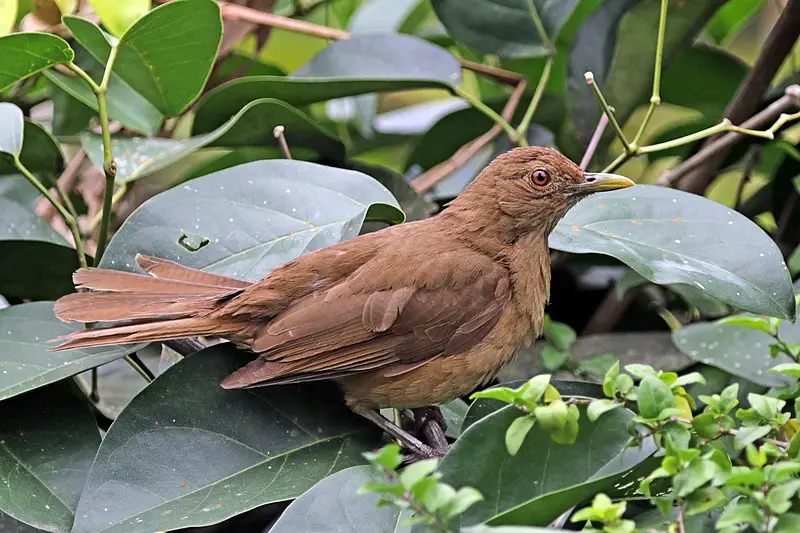
The Clay-colored Thrush is a common Middle American bird belonging to the thrush family. It has become known as Costa Rica’s national bird, going by the name yigüirro in Spanish.
Not only does it inhabit South Texas and parts of northern Colombia, but its range extends westward and northward from Isthmus Tehuantepec too.
It has an overall buffy coloration with brownish upperparts which help distinguish this species from other birds within its habitat.
Additionally, some individuals have white tips on their tail feathers that further serve to differentiate them amongst others of their kind.
This hardy species continues to thrive in many different habitats across Central America making it one of the most widespread songbirds around.Scientific classification:
| Kingdom | Animalia |
| Phylum | Chordata |
| Class | Aves |
| Order | Passeriformes |
| Family | Turdidae |
| Genus | Turdus |
| Species | T. grayi |
Also Featured In: Costa Rica Birds, Common Latin America Birds
22. Roseate Spoonbill
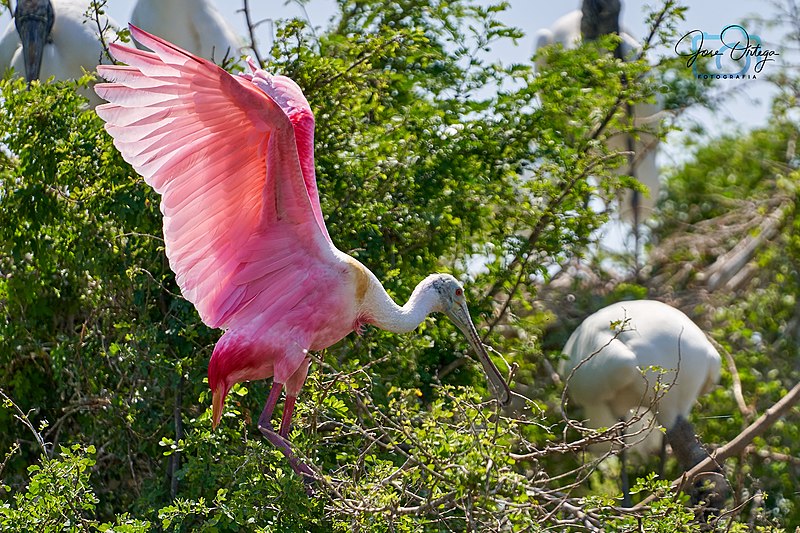
The Roseate Spoonbill is a beautiful and majestic bird found in both North and South America.
It belongs to the ibis family, Threskiornithidae, and its vibrant pink colour comes from canthaxanthin pigment derived from their diet of crustaceans like shrimp.
Sadly plume hunting has almost driven this species close to extinction during the 18th and 19th centuries but fortunately it’s making a comeback due to conservation efforts made by dedicated wildlife organisations.
Its large spoon-like bill helps them filter out food sources such as small fish or frogs from shallow water areas while they wade through mudflats with their long legs looking for something tasty.
With its unique appearance, graceful wingspan amd impressive flight capabilities, the Roseate Spoonbill is an incredibly photogenic animal that will captivate any viewers attention who happen to be lucky enough witness it in all its glory.Scientific classification:
| Kingdom | Animalia |
| Phylum | Chordata |
| Class | Aves |
| Order | Pelecaniformes |
| Family | Threskiornithidae |
| Genus | Platalea |
| Species | P. ajaja |
Also Featured In: Famous Paintings Birds, Flight Birds You Should Know
23. Wood Stork
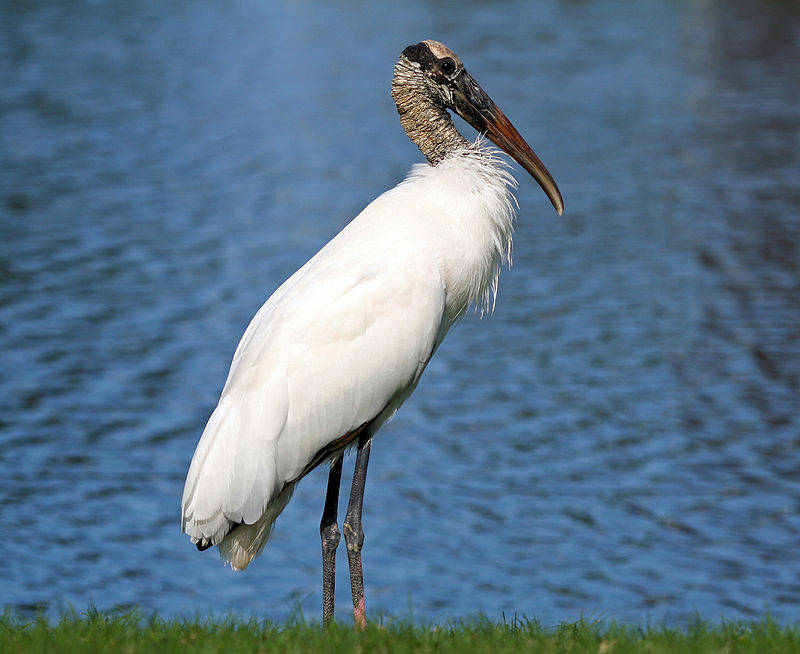
The Wood Stork is a large wading bird found in subtropical and tropical habitats throughout the Americas, including the Caribbean. It stands out from other storks due to its distinctive white head and neck feathers.
The wood stork has an impressive wingspan of up to 6 feet wide, making it one of the largest birds in North America.
Although usually seen near water sources such as swamps or wetlands looking for food like fish, crabs, frogs and even small reptiles they can sometimes be spotted far away from their natural habitat during migration season.
This species is also one of few that breeds annually in North America with nests typically built on platforms made by humans or animals near water bodies or ponds.Scientific classification:
| Kingdom | Animalia |
| Phylum | Chordata |
| Class | Aves |
| Order | Ciconiiformes |
| Family | Ciconiidae |
| Genus | Mycteria |
| Species | M. americana |
Also Featured In: Georgia Birds, Autumn Birds You Should Know
24. Ferruginous Pygmy Owl
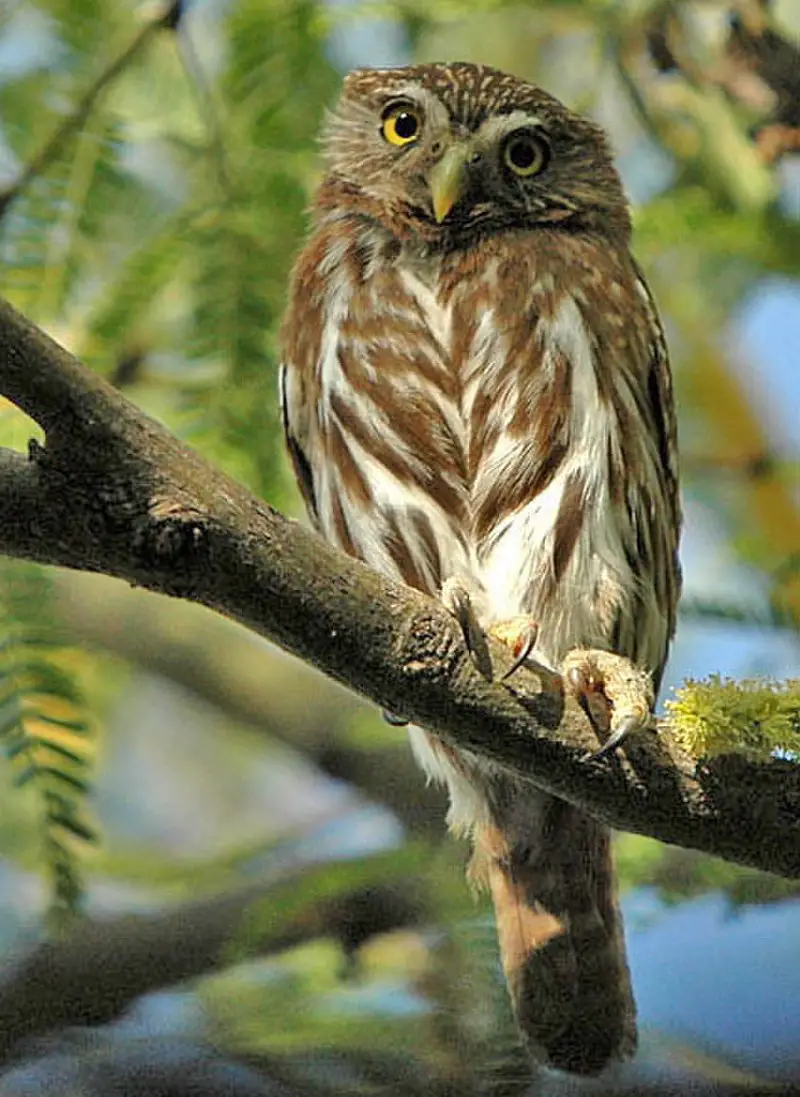
The ferruginous pygmy owl is a small species of owl that can be found throughout much of Central and South America, as well as parts of the United States.
It has rusty-brown feathers on its body, giving it an overall “ferruginous” colouration. The bird feeds mainly on insects and other invertebrates, but also eats some larger prey such as lizards or mice when available.
During breeding season the birds build nests in tree cavities to raise their young. They are usually nocturnal creatures but may become active during daylight hours if disturbed by humans or predators nearby.
This adaptable little raptor is often seen perching atop buildings or street lights in urban areas where they have adapted to live alongside human activity while still finding food sources within cities and townships alike.Scientific classification:
| Kingdom | Animalia |
| Phylum | Chordata |
| Class | Aves |
| Order | Strigiformes |
| Family | Strigidae |
| Genus | Glaucidium |
| Species | G. brasilianum |
Also Featured In: Uruguay birds,
25. Green Jay
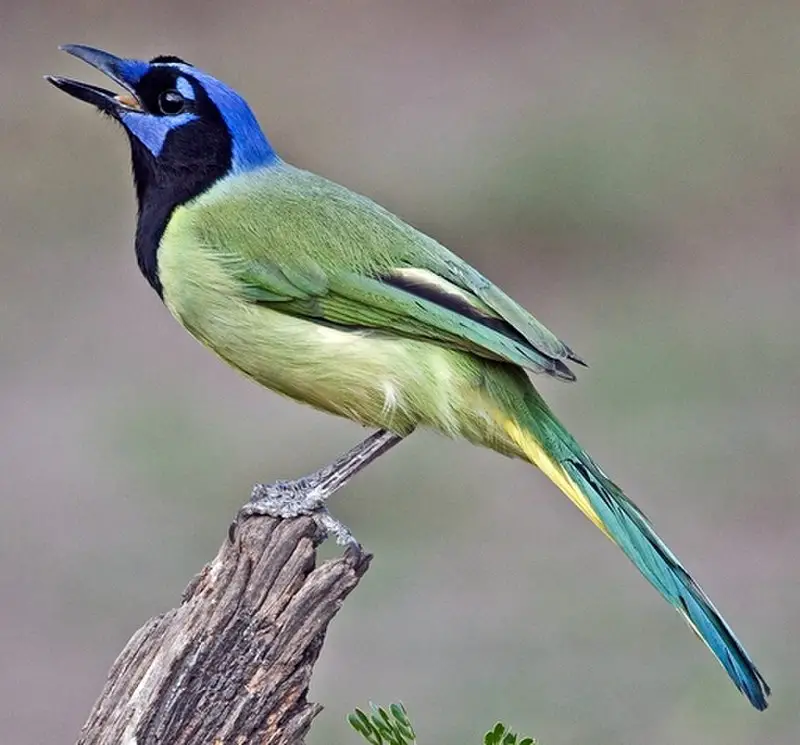
The green jay is a beautiful bird that can be found in Central America. It has blue and black heads, with green wings, mantle and tail. The bill is black while the eye rings are yellow or brown.
Its legs are dark coloured and it measures 27 cm in length. Their diet consists of arthropods, vertebrates, seeds and fruit which provide them with essential nutrients for their survival.
They have adapted to many different habitats like forests, fields and gardens where they live peacefully alongside other birds species until humans interfere with their environment by cutting down trees or polluting water sources amongst others activities that disrupts nature’s balance thus affecting these amazing creatures negatively.Scientific classification:
| Kingdom | Animalia |
| Phylum | Chordata |
| Class | Aves |
| Order | Passeriformes |
| Family | Corvidae |
| Genus | Cyanocorax |
| Species | C. luxuosus |
Also Featured In: Belize Birds,
26. Common Ground Dove
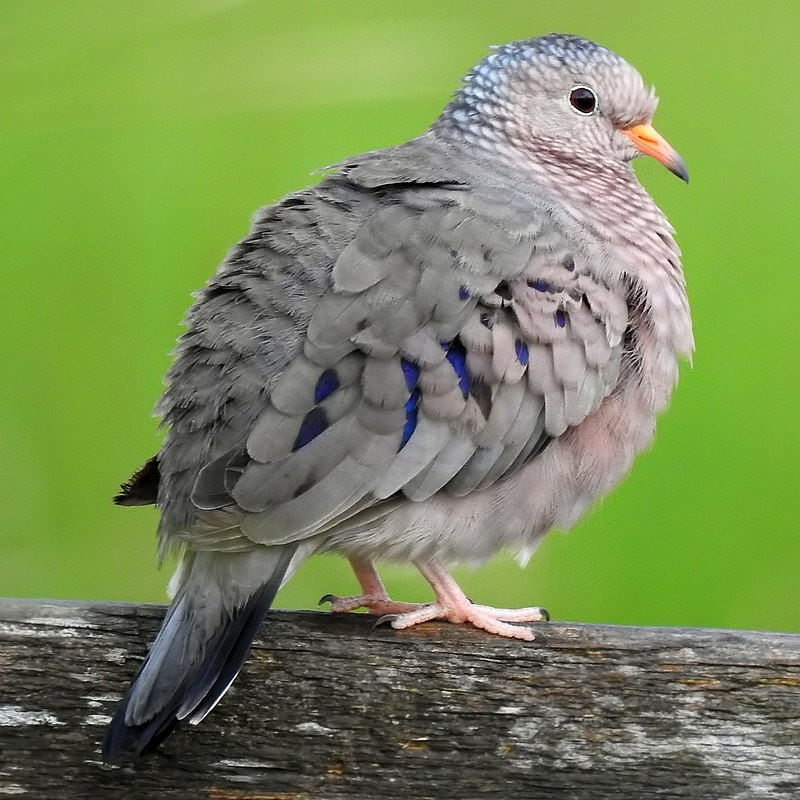
The Common Ground Dove is a small bird that can be found in the southern United States, Central America, the Caribbean and northern South America.
It’s considered to be one of the smallest dove species in North American with an average length of around 6–7 inches.
This ground-dwelling species spends most of its time on foot but has been known to fly when necessary or threatened.
The plumage is pale grayish brown above while their bellies are white and speckled with black spots along their wings.
Its diet consists mainly of seeds from grasses and other low vegetation which it forages for by walking slowly across open fields or lawns looking for food items like berries, grains, insects, spiders and snails.Scientific classification:
| Kingdom | Animalia |
| Phylum | Chordata |
| Class | Aves |
| Order | Columbiformes |
| Family | Columbidae |
| Genus | Columbina |
| Species | C. passerina |
Also Featured In: Barbados Birds, Caribbean Birds
27. Clapper Rail
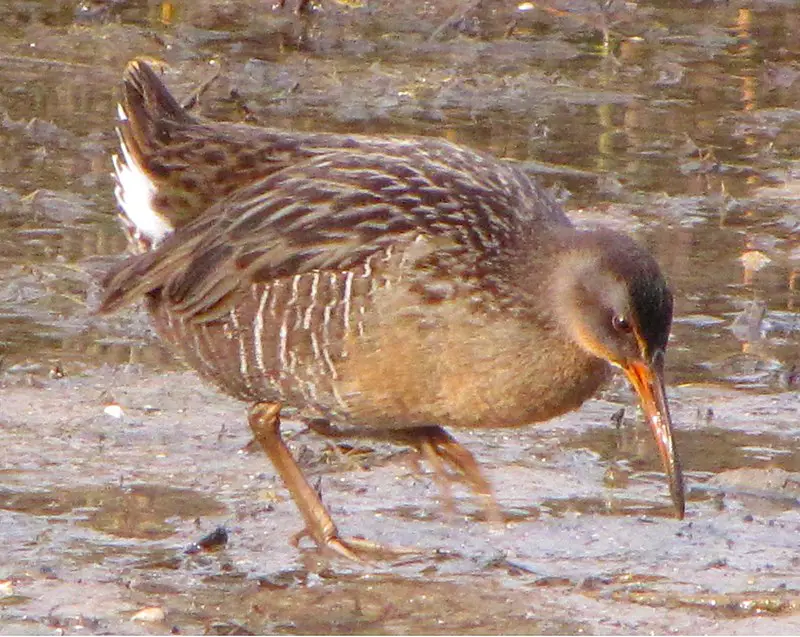
The Clapper Rail is a large, brown bird that belongs to the Rallidae family. It is found in wetlands along the eastern coast of America, Mexico and some Caribbean Islands.
This species was once considered to be related to Mangrove Rails but recent taxonomic studies have shown otherwise.
They are quite vocal with their loud calls which sound like someone clapping two stones together hence its name ‘Clapper’.
These birds feed on small crabs, fishes and insects in coastal marshes and swamps making them an important part of wetland ecosystems.
In order for these birds to thrive actions should be taken by governments such as restoring habitats or creating new ones so they can carry out their activities without any disturbance from humans or predators.Scientific classification:
| Kingdom | Animalia |
| Phylum | Chordata |
| Class | Aves |
| Order | Gruiformes |
| Family | Rallidae |
| Genus | Rallus |
| Species | R. crepitans |
Also Featured In: Saint Kitts & Nevis birds, Long Island Birds You Should Know
28. Least Grebe
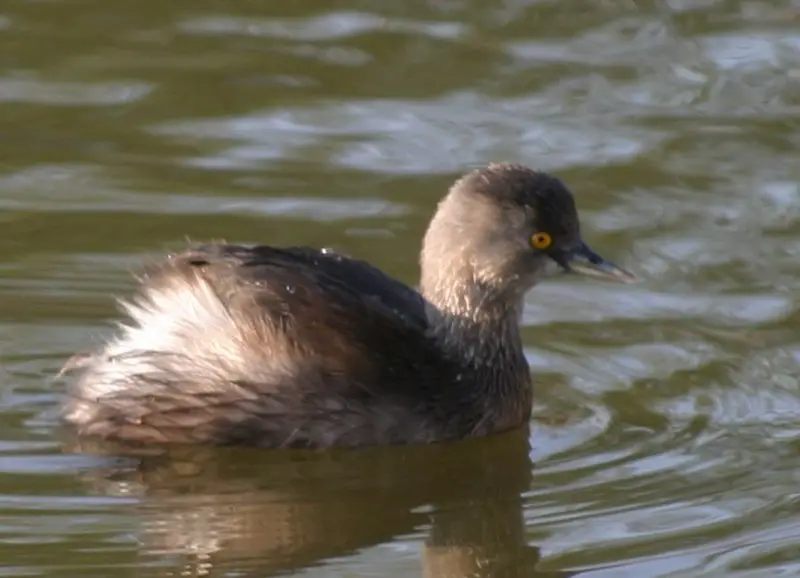
The Least Grebe is the smallest member of the grebe family and can be found in North, Central and South America. It measures around 21-27 cm long with a weight of 112-180 g.
Its range extends from southwestern United States to Argentina as well as Trinidad, Tobago, Bahamas and Greater Antilles.
The bird has an interesting plumage which varies depending on its subspecies; it may have dark brown upperparts or rusty back feathers along with whitish underparts having buff spots near the throat area.
In addition to this its neck has black streaks while head may be grey or reddish brown.
This species feeds mainly on small aquatic invertebrates like insects larvae , crustaceans etc., but also eats fish occasionally when available.
Breeding season for least grebes occurs during summer months between April -July where they build floating nests among reeds in shallow water bodiesScientific classification:
| Kingdom | Animalia |
| Phylum | Chordata |
| Class | Aves |
| Order | Podicipediformes |
| Family | Podicipedidae |
| Genus | Tachybaptus |
| Species | T. dominicus |
Also Featured In: Cayman Islands birds,
29. Black-Crested Titmouse
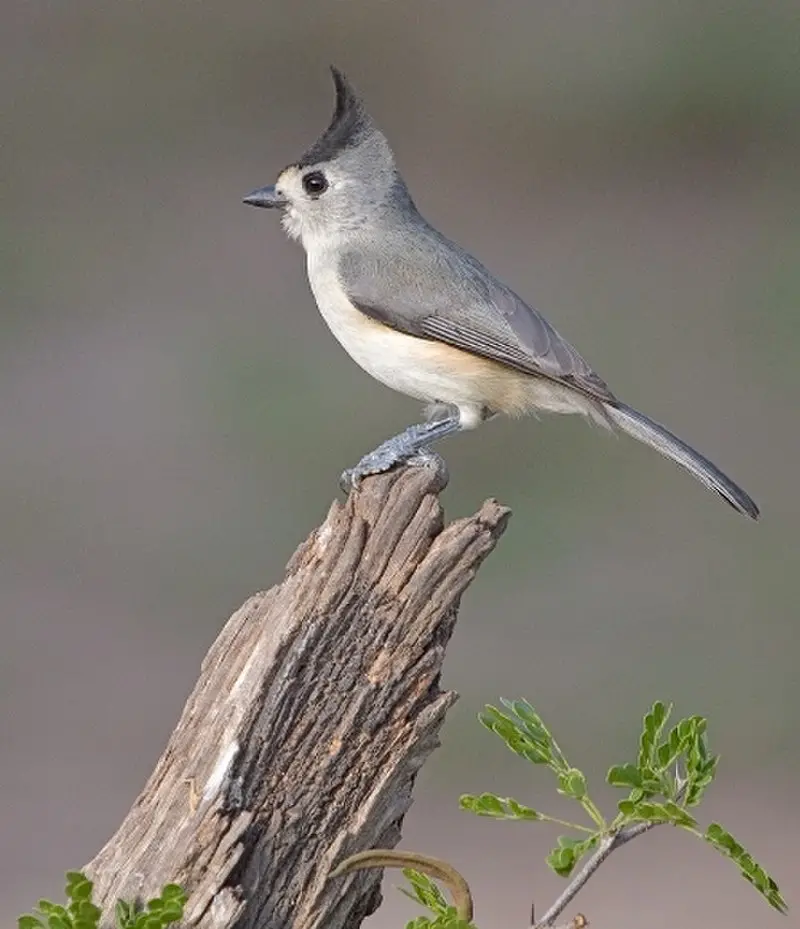
The Black-crested titmouse is a passerine bird in the Paridae family and was recently recognised as its own species.
Native to southern Texas, Oklahoma and east central Mexico, they have been known to make their way as far north and east as St. Louis Missouri through vagrancy.
The birds measure between 5 – 6 inches long with an overall grey colouring featuring white underparts and black crowns on their heads giving them the name ‘Black-crested’.
These birds are omnivores foraging for insects, fruit or seeds depending on seasonality of food sources available at different times throughout the year.
They form monogamous pairs typically making nests of twigs lined with grasses & feathers which both parents take part in building & raising young before fledging.Scientific classification:
| Kingdom | Animalia |
| Phylum | Chordata |
| Class | Aves |
| Order | Passeriformes |
| Family | Paridae |
| Genus | Baeolophus |
| Species | B. atricristatus |
Also Featured In: Chickadees Birds, Central Texas Birds
30. White-Tipped Dove
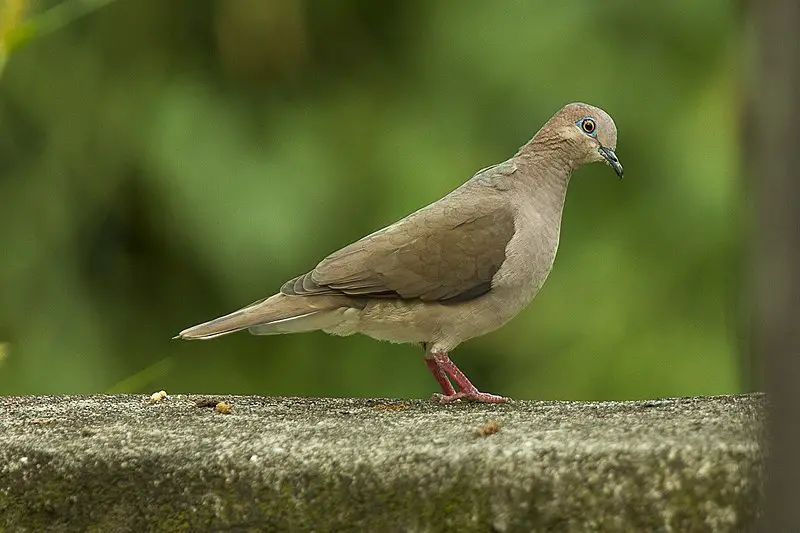
The White-tipped Dove is a majestic bird found in tropical areas of the New World, from southern Texas and Mexico all the way to western Peru and Argentina.
It carries with it an interesting scientific name: Leptotila verreauxi, named after French naturalists Jules and Edouard Verraux.
This species also breeds on offshore islands along northern South America, including Trinidad.
It has distinctive white tips on its wings which makes them easily identifiable while they are flying as well as when perched.
They have grayish brown feathers overall that helps camouflage them amongst trees or foliage making them difficult to spot otherwise.
The males tend to be slightly larger than females but other than that there isn’t much difference between their appearance aside from courtship rituals where both sexes will bow together for recognition before mating season starts.Scientific classification:
| Kingdom | Animalia |
| Phylum | Chordata |
| Class | Aves |
| Order | Columbiformes |
| Family | Columbidae |
| Genus | Leptotila |
| Species | L. verreauxi |
Also Featured In: Doves Birds, Birds You’ll Find in the Rio Grande Valley
31. Bat Falcon
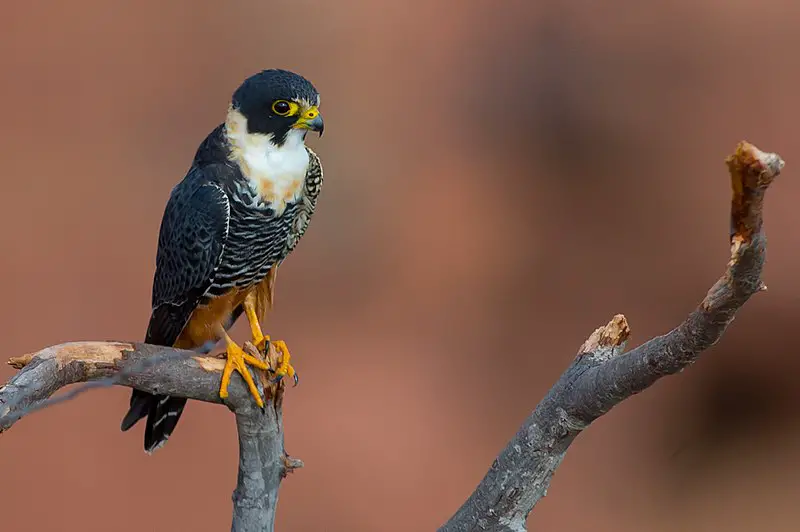
The Bat Falcon is a small falcon found in Mexico, Central and South America, as well as Trinidad. It was previously known as Falco albigularis but has since been renamed to its current name.
This bird of prey looks similar to the Orang-utan with its brownish-gray plumage and bright blue cere on top of their beaks. They are generally around 9 inches long with a wingspan reaching up to 20 inches across.
The Bat Falcons prefer open savanna or woodland habitats where they can hunt for insects or small birds during the day.
These birds rely heavily on flying insect populations which makes them vulnerable when these numbers drop due too environmental changes such climate change making it important that we protect this species from further endangerment by preserving suitable habitat types so they can continue living there happily.Scientific classification:
| Kingdom | Animalia |
| Phylum | Chordata |
| Class | Aves |
| Order | Falconiformes |
| Family | Falconidae |
| Genus | Falco |
| Species | F. rufigularis |
Also Featured In: Falcons Species, Puerto Vallarta Birds You Should Know
32. Scissor-Tailed Flycatcher
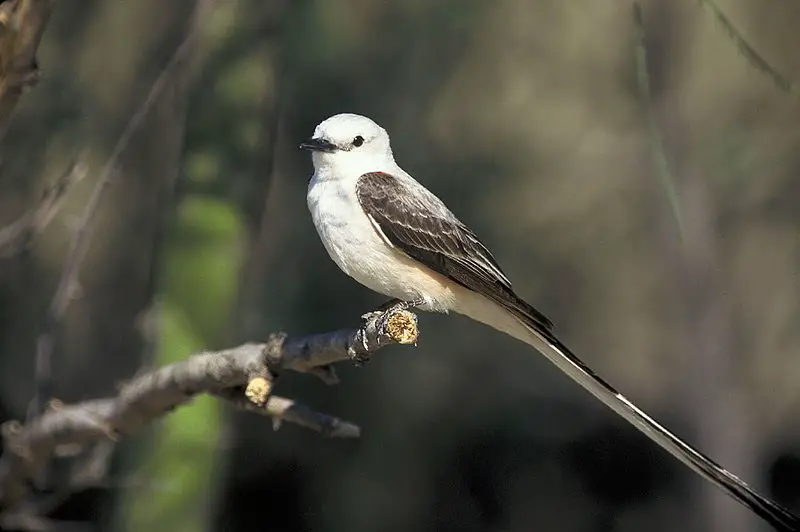
The scissor-tailed flycatcher is a beautiful bird, belonging to the Tyrannus genus of kingbirds. It is known by various names such as Texas Bird-of Paradise and Swallow-tailed Flycatcher.
This insectivorous bird has an impressive long tail which it uses for courtship displays and aerial acrobatics – making it quite the showstopper.
Its range includes North America and Central South American regions where they breed in open fields, pastures or grasslands with scattered trees available.
They feed on insects like dragonflies, damselflies and small moths that they catch while gliding through air gracefully with their wings spread apart wide.
To watch this amazing creature soar freely over its habitat would be nothing short of breathtaking.Scientific classification:
| Kingdom | Animalia |
| Phylum | Chordata |
| Class | Aves |
| Order | Passeriformes |
| Family | Tyrannidae |
| Genus | Tyrannus |
| Species | T. forficatus |
Also Featured In: Flycatchers Species, Summer Birds that Live around Us
33. Say’s Phoebe
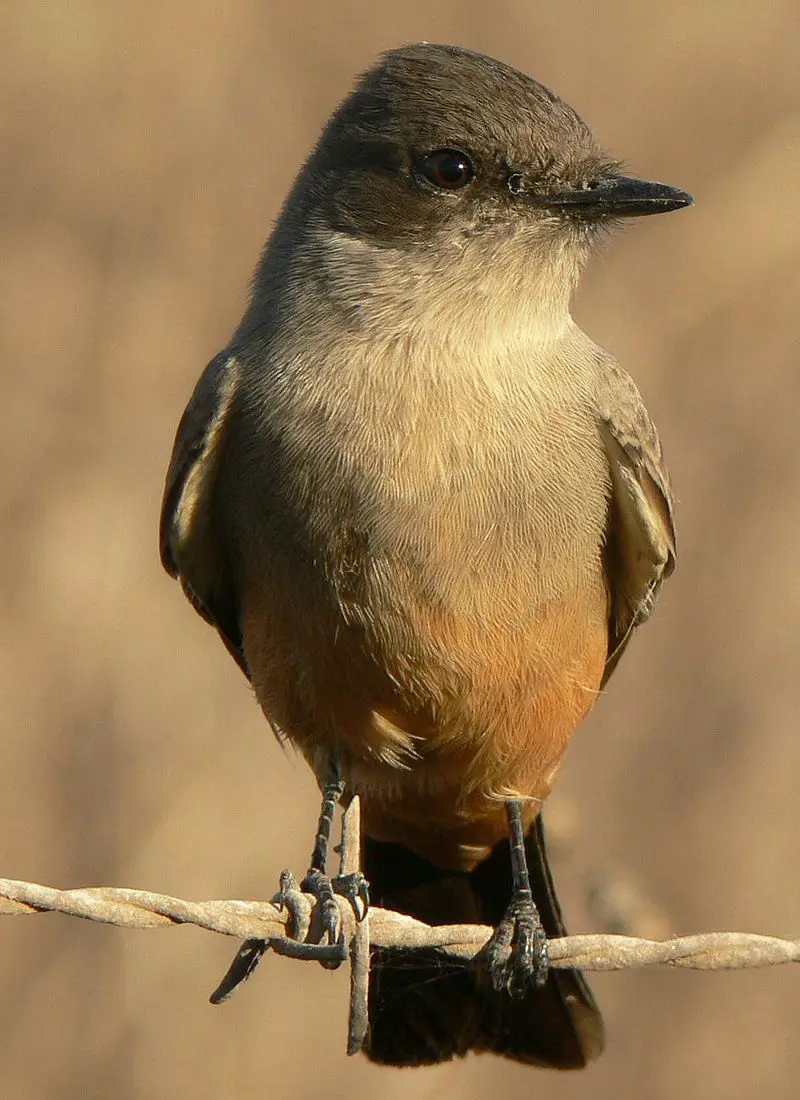
Say’s phoebe is a bird from the tyrant flycatcher family native to western North America. It was named for American naturalist Thomas Say, who first described it in 1825.
This species prefers dry and desolate areas as its habitat. Its brown plumage with whitish underside makes them quite easy to spot among other birds of similar size.
They are also known for their distinctive call; “phoe-bee” which they repeat often throughout the day while perched on fence posts or tree branches scanning their surroundings looking out for food sources such as flying insects, small frogs and lizards etc..
Their nests are made up of plant materials like grasses lined with hair or feathers placed inside cavities either under overhangs or in abandoned structures like barns and sheds providing ample protection against predators such as hawks and foxes.Scientific classification:
| Kingdom | Animalia |
| Phylum | Chordata |
| Class | Aves |
| Order | Passeriformes |
| Family | Tyrannidae |
| Genus | Sayornis |
| Species | S. saya |
Also Featured In: Phoenix Birds You Should Know, Birds that Live in Arizona Desert
34. Laughing Gull
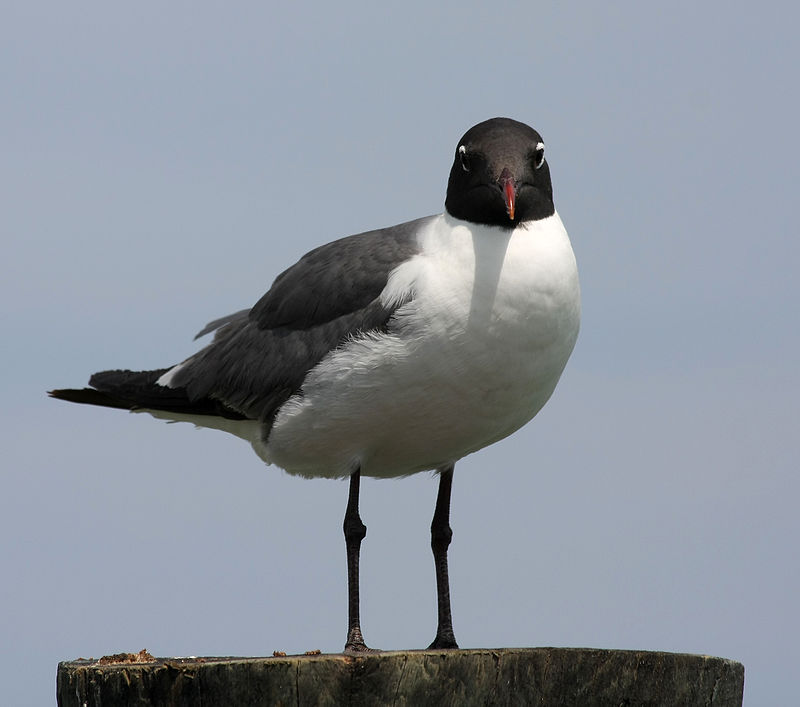
The Laughing Gull is a medium-sized bird with gray wings, black head and white underparts. It has bright red legs and bill which make it easily distinguishable from other gulls.
The name comes from its unique laughing call which can be heard in coastal areas throughout the Americas where they breed. They are opportunistic omnivores that feed on fish, carrion, insects or even garbage when available.
During breeding season these birds form large colonies along the Atlantic coast of North America as well as parts of northern South America and Caribbean islands.
There are two subspecies; L megalopturus found in Canada to Central America while L atricilla inhabits rest of their range..
These species have become more common inland due to human settlement near coasts creating ideal habitat for them but also making them scavengers around urban areas.Scientific classification:
| Kingdom | Animalia |
| Phylum | Chordata |
| Class | Aves |
| Order | Charadriiformes |
| Family | Laridae |
| Genus | Leucophaeus |
| Species | L. atricilla |
Also Featured In: Gulls Species, Birds that can be Seen in Outer Banks
35. Green Parakeet
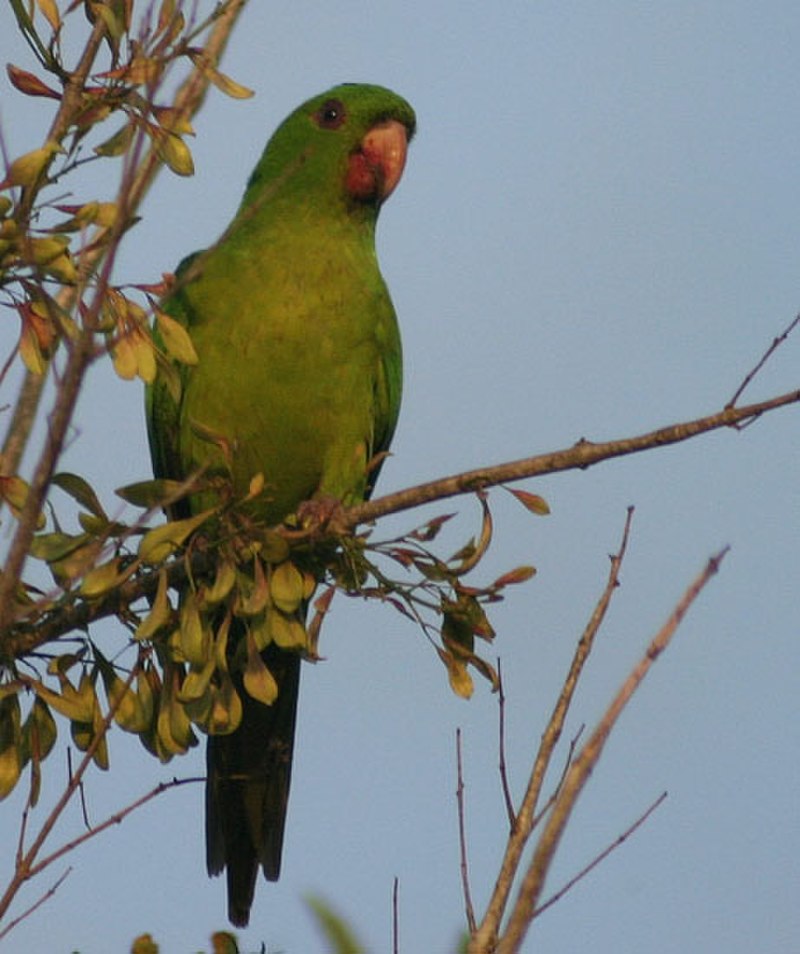
The green parakeet is a beautiful medium-sized bird, measuring up to 32 cm in length. It has distinctive bright green feathers and a yellow beak, making it truly stand out among other birds.
In the wild, these parrots primarily feed on seeds, various fruits and corn as well as live in scrubland or swampy areas across North and Central America stretching from Texas to Nicaragua.
Unfortunately they are sometimes considered crop pests due to their feeding habits.
Despite this behaviour however, the stunning colouration of these birds makes them an interesting addition to any landscape.Scientific classification:
| Kingdom | Animalia |
| Phylum | Chordata |
| Class | Aves |
| Order | Psittaciformes |
| Family | Psittacidae |
| Genus | Psittacara |
| Species | P. holochlorus |
Also Featured In: Parrots Species, Green Birds Commonly Found in Florida
36. Lincoln’s Sparrow
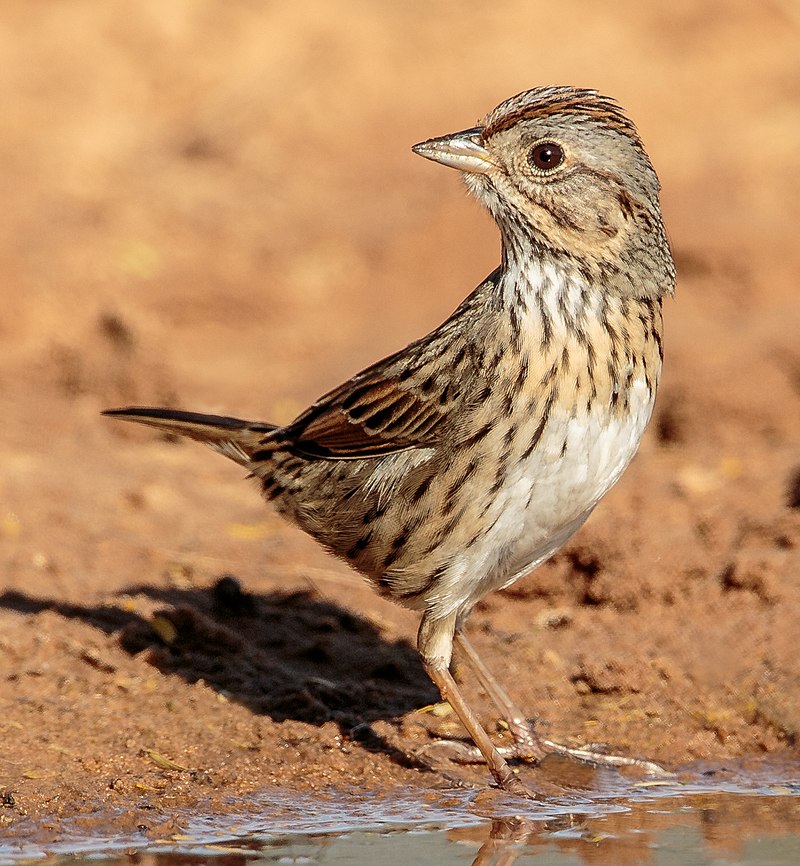
Lincoln’s sparrow is a small passerine bird native to North America. It has brown upperparts, white underparts and a distinctive light-gray eyebrow line above its eyes.
The species usually stays hidden in thick ground cover but can be identified by its sweet, wrenlike song.
Lincoln’s sparrow belongs to the genus Melospiza along with two other species: the Song Sparrow (M.melodia) and Swamp Sparrow (M. georgiana).
This elusive yet beautiful bird inhabits well-covered areas such as wetlands, grasslands, shrubland valleys, pastures and open woodlands across most of Canada and parts of northern USA throughout summer months before migrating south for winter season.Scientific classification:
| Kingdom | Animalia |
| Phylum | Chordata |
| Class | Aves |
| Order | Passeriformes |
| Family | Passerellidae |
| Genus | Melospiza |
| Species | M. lincolnii |
Also Featured In: Sparrows Species, Birds that Live in the Grasslands
37. Olive Sparrow
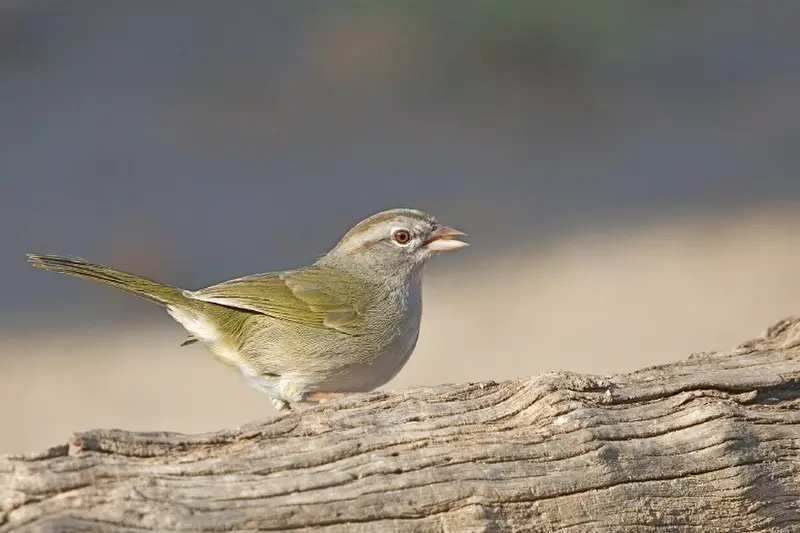
The Olive Sparrow is a species of American sparrow in the family Passerellidae. It has an olive-colored back, with white streaks on its sides and dark brown stripes above its eyes.
Its wings are also slightly darker than its body coloration. This small bird grows to be between 5.5 – 6.1 inches long and can typically be found in Belize, Costa Rica, Guatemala, Honduras Mexico Nicaragua and southern Texas (Val Verde County).
The Olive Sparrow feeds mainly on insects but will eat some seeds as well as berries when they become available during certain times of the year making them omnivores by nature.
They usually make their nests high up in trees or bushes where there’s plenty of cover from predators such as hawks or owls which may prey upon them if given the opportunity to do so.Scientific classification:
| Kingdom | Animalia |
| Phylum | Chordata |
| Class | Aves |
| Order | Passeriformes |
| Family | Passerellidae |
| Genus | Arremonops |
| Species | A. rufivirgatus |
Also Featured In: Birds That Live around South Padre Island,
38. Ladder-Backed Woodpecker
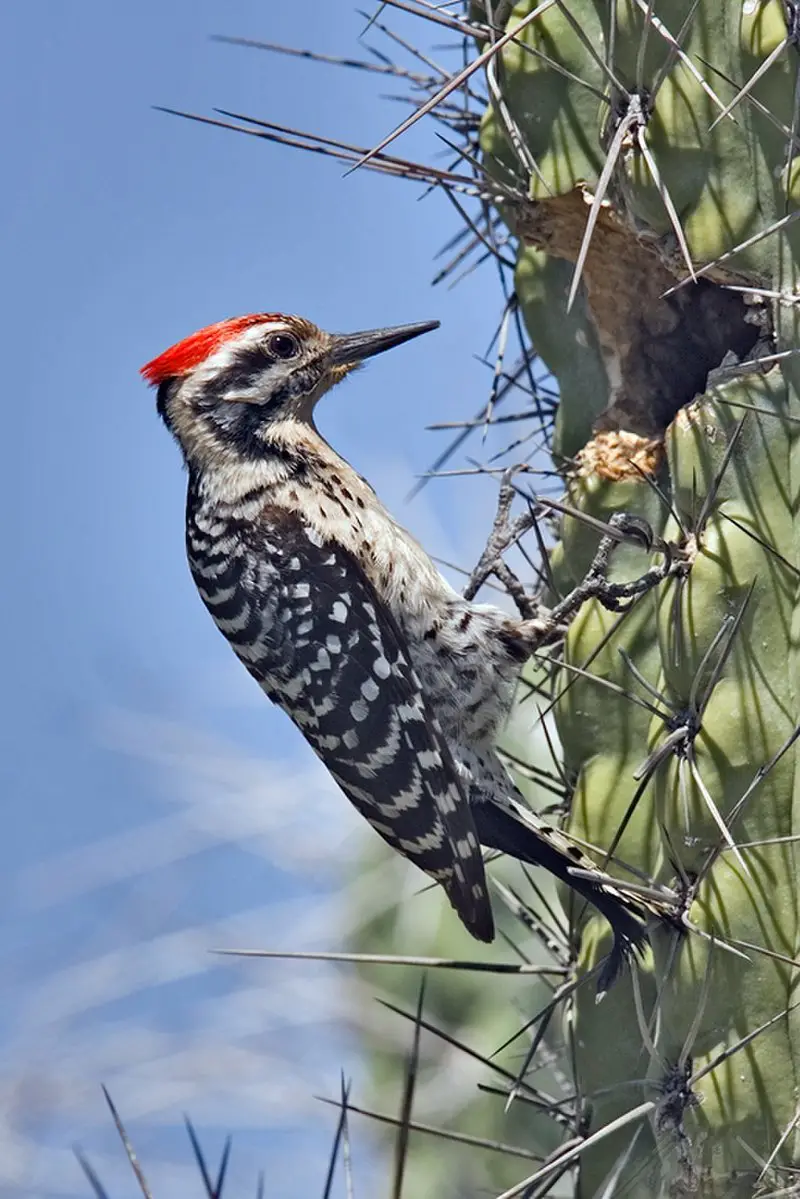
The Ladder-backed Woodpecker is a small black and white bird native to North America.
At about 16.5-19 cm in length, it has a characteristic barred pattern on its back resembling the rungs of a ladder, as well as speckled black rump and cream colored underparts on its breast and flanks.
These birds can be found inhabiting woodlands across their range, where they feed mostly on insects that they find by drilling into trees or hunting from exposed branches.
Their call consists of short chirps repeated every few seconds with an occasional longer trill thrown in for good measure.
They are also known to use twigs or other objects to probe crevices while searching for food – making them quite resourceful hunters indeed.Scientific classification:
| Kingdom | Animalia |
| Phylum | Chordata |
| Class | Aves |
| Order | Piciformes |
| Family | Picidae |
| Genus | Dryobates |
| Species | D. scalaris |
Also Featured In: Woodpeckers Species, Birds that Live in the Grand Canyon National Park
39. Curve-Billed Thrasher
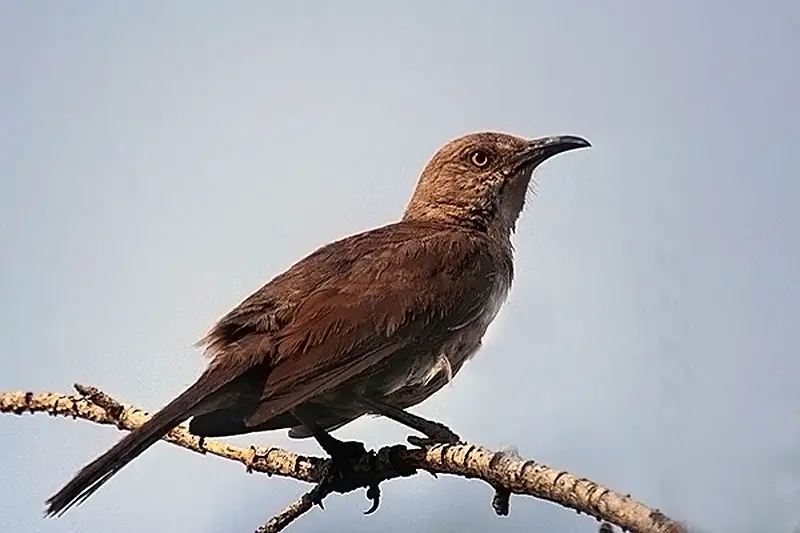
The Curve-billed Thrasher is a medium-sized bird native to Mexico and the southwestern United States. It lives mainly in desert areas, where it can be found foraging on the ground for its insect prey.
Its name comes from its curved bill, which aids in rooting out insects and other food sources.
The species has several subspecies that are geographically separated throughout much of their range; allopatric speciation likely played an important role here as well.
Despite being non-migratory, this thrasher will sometimes travel long distances when resources become scarce or during courtship displays with potential mates.
A successful predator of grasshoppers, beetles and other arthropods, the Curve-billed Thrasher plays an essential role in maintaining healthy ecosystems by controlling pest populations.Scientific classification:
| Kingdom | Animalia |
| Phylum | Chordata |
| Class | Aves |
| Order | Passeriformes |
| Family | Mimidae |
| Genus | Toxostoma |
| Species | T. curvirostre |
Also Featured In: birds of Arizona, Birds that Live in the Deserts
40. Pyrrhuloxia
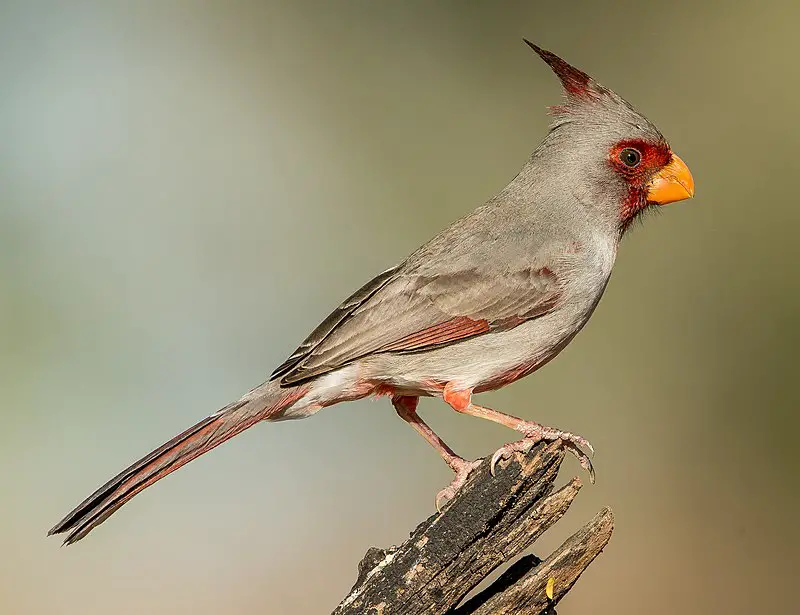
The Pyrrhuloxia, also known as the desert cardinal, is a stunningly beautiful bird native to the American Southwest and northern Mexico.
With its red crest and wings, short stout bill, it closely resembles the Northern Cardinal and Vermilion Cardinal of its same genus.
It has an average size compared to other songbirds in this area at around 18cm long with a wingspan of up to 28 cm wide.
Its diet mainly consists of small insects such as grasshoppers but they will occasionally eat some fruit or seeds too.
The Pyrrhuloxia’s singing ability rivals many birds in that region due to their clear whistles which can be heard from afar on quiet mornings.
The beauty of these birds makes them very popular among birdwatchers who come from all over just for a chance glimpse of one.Scientific classification:
| Kingdom | Animalia |
| Phylum | Chordata |
| Class | Aves |
| Order | Passeriformes |
| Family | Cardinalidae |
| Genus | Cardinalis |
| Species | C. sinuatus |
Also Featured In: Red birds You’ll See in Arizona, Red Birds You’ll See in Oklahoma
41. Hooded Oriole
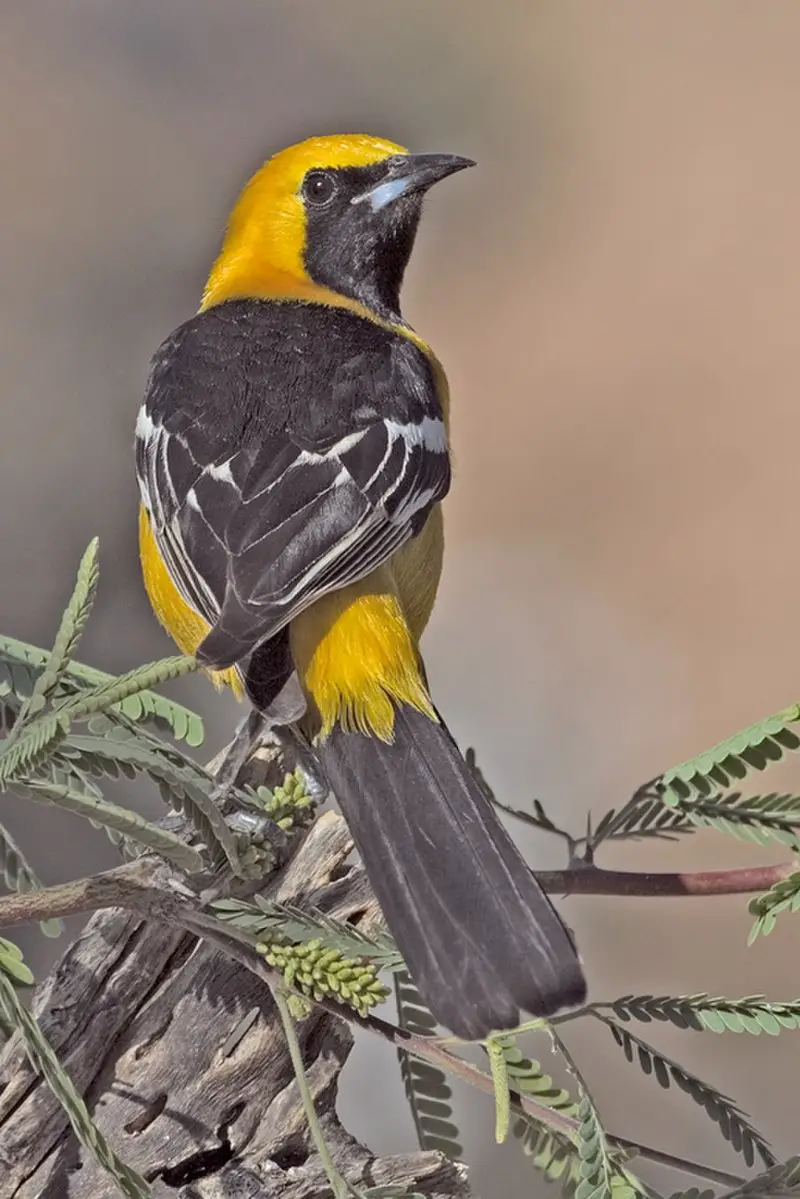
The Hooded Oriole is a medium-sized New World bird with bright, vibrant colours. The male has an orange to yellow body and black back, face, tail and bib.
Its wings have two white bars that stand out against the dark feathers surrounding it. The female is more of an olive colouration but also shows some yellow accents too.
Both sexes have a curved bill which is completely black in colour as well as having white wing bars on its wings for easy identification from other birds in the area.
It typically lives in open woodlands or tropical areas where there are plenty of trees providing food sources such as insects and fruit for them to eat while they perch amongst their branches during nesting season.Scientific classification:
| Kingdom | Animalia |
| Phylum | Chordata |
| Class | Aves |
| Order | Passeriformes |
| Family | Icteridae |
| Genus | Icterus |
| Species | I. cucullatus |
Also Featured In: Birds Live Near San Diego, Common Yellow Birds of Idaho
42. Long-Billed Thrasher
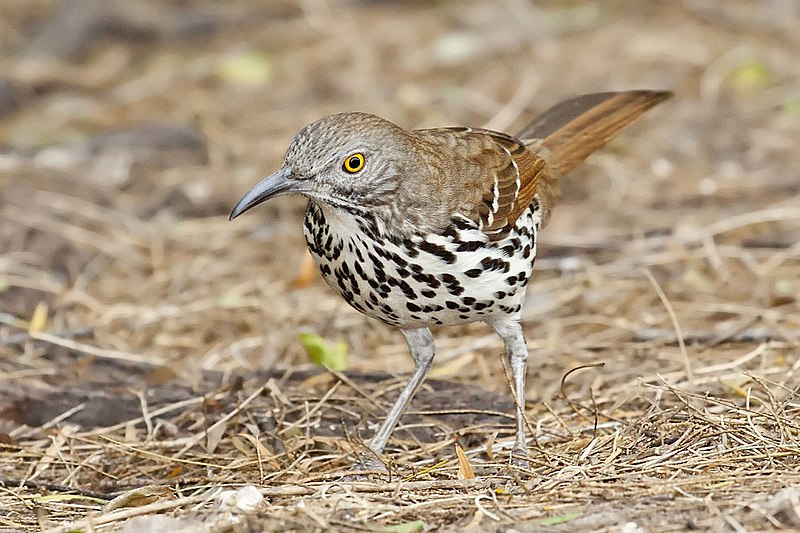
The Long-billed Thrasher is a medium-sized songbird found in South Texas and eastern Mexico.
It has similar features to the Brown Thrasher, such as its calls, appearance and behaviors; although they do not share overlapping ranges except during winter when the Brown Thrasher will reside temporarily in northern areas of where the Long-billed resides.
This species boasts an impressive long bill for probing into ground cover looking for insects, fruits and other food sources – this also serves well when singing its loud melodious songs from elevated perches.
The mottled brown plumage allows them camouflage amongst dense shrubs or trees making it harder to detect by predators.
When nesting season arrives these thrashers can become quite territorial defending their nests fiercely against intruders.Scientific classification:
| Kingdom | Animalia |
| Phylum | Chordata |
| Class | Aves |
| Order | Passeriformes |
| Family | Mimidae |
| Genus | Toxostoma |
| Species | T. longirostre |
Also Featured In: birds of brown,
43. Gray Hawk
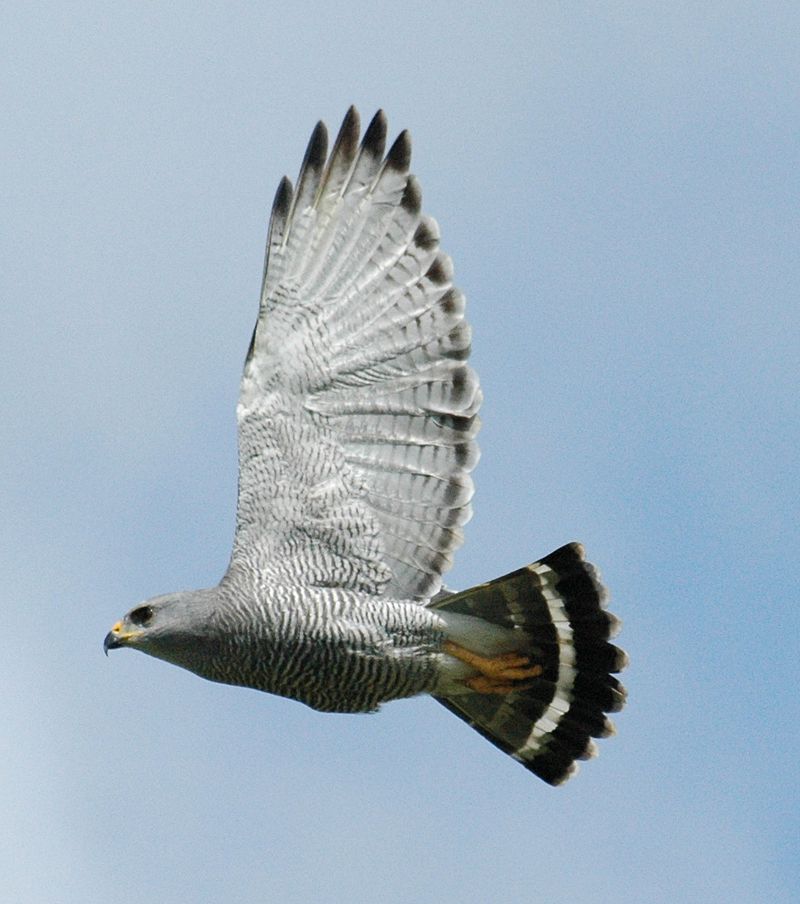
The Gray Hawk is a small raptor that inhabits open country and forest edges, ranging from Costa Rica up to the southwestern United States.
It has a length of 18 to 24 inches and is easily identifiable by its pale grey upperparts, with black-and-white barred tail feathers.
Its underparts are white or light buffy in color, with dark streaks on its breast. This species feeds mainly on rodents, lizards and insects but may also take larger prey such as snakes and other birds when needed.
The female builds an early nest made out of sticks during breeding season which usually begins around March through June depending on location.
Overall this hawk plays an important role in controlling rodent populations throughout it’s range making it ecologically beneficial for humans living nearby.Scientific classification:
| Kingdom | Animalia |
| Phylum | Chordata |
| Class | Aves |
| Order | Accipitriformes |
| Family | Accipitridae |
| Genus | Buteo |
| Species | B. plagiatus |
Also Featured In: birds of gray, Birds that Live in Tabasco
44. Red-Shouldered Hawk
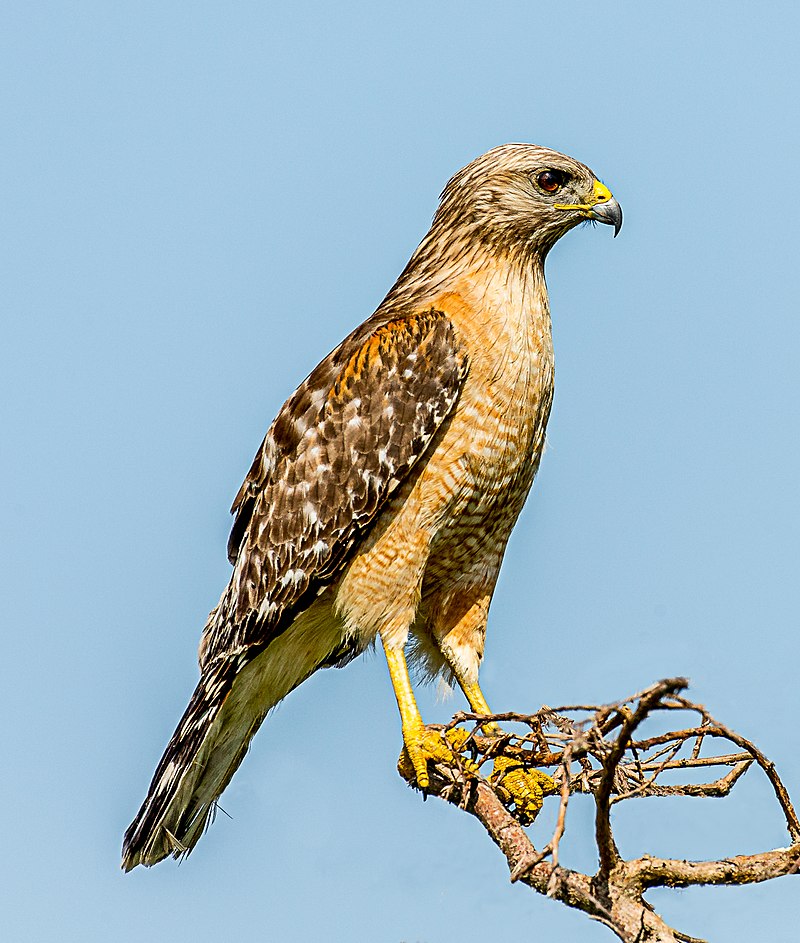
The red-shouldered hawk, also known as Buteo lineatus, is a medium-sized bird of prey found in eastern North America and along the coast of California and northern to northeastern-central Mexico.
While many of these hawks are permanent residents within their range, northern populations do migrate, with most traveling to central Mexico.
The species faces numerous threats to its survival, with deforestation being a primary issue.
Despite the many challenges they face, these birds are an important part of their ecosystems, primarily feeding on rodents, small mammals, and amphibians.
In addition to their hunting capabilities, these hawks are known for their striking appearance, featuring reddish brown shoulder feathers and bold black and white striped wings.
Overall, the red-shouldered hawk is a fascinating and important bird that plays a vital role in its surroundings.Scientific classification:
| Kingdom | Animalia |
| Phylum | Chordata |
| Class | Aves |
| Order | Accipitriformes |
| Family | Accipitridae |
| Genus | Buteo |
| Species | B. lineatus |
Also Featured In: Birds Commonly Found in New York, Birds Live in Arkansas
45. Audubon’s Oriole
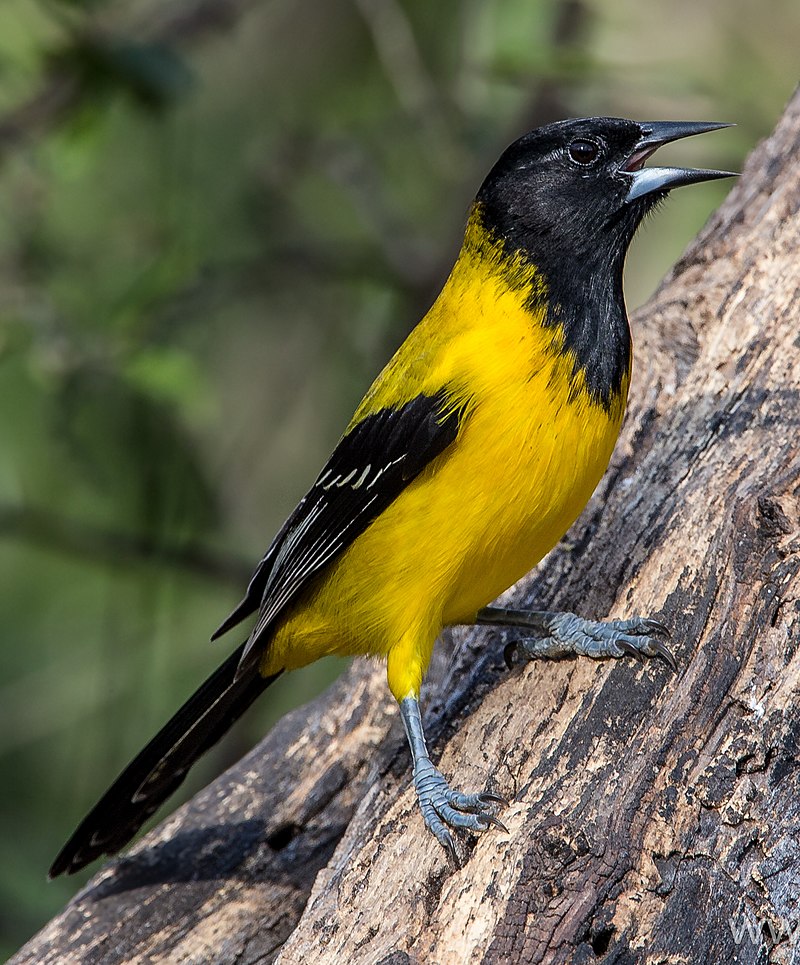
Audubon’s oriole is a beautiful bird that can be found in southeastern Texas and the Mexican coast. It has a unique appearance with a black hood and yellow body, making it distinguishable from other oriole species.
There are four subspecies of the Audubon’s oriole, each with a slightly different range. The bird inhabits forests and thickets and is commonly seen in these areas. It is the only species of oriole with a black hood and yellow body.
The bird has two allopatric breeding ranges, with the westernmost range extending from Nayarit down to southern Oaxaca.
Audubon’s oriole is a passerine, which means that it has three toes pointing forward and one pointing backward. It is a beautiful bird that is cherished by bird enthusiasts and nature lovers alike.Scientific classification:
| Kingdom | Animalia |
| Phylum | Chordata |
| Class | Aves |
| Order | Passeriformes |
| Family | Icteridae |
| Genus | Icterus |
| Species | I. graduacauda |
Also Featured In: Yellow Indiana Birds, Black Birds that Live around United States of America
46. Plain Chachalaca
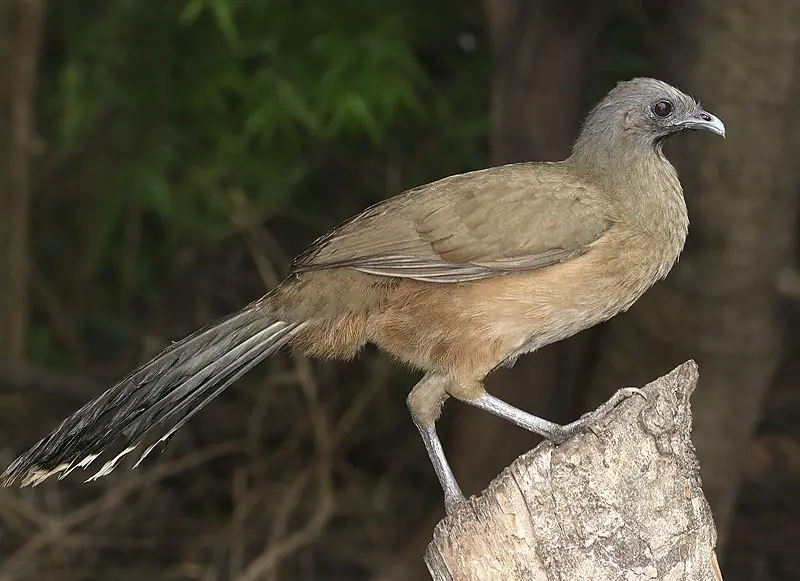
The plain chachalaca is a sizeable bird belonging to the Cracidae family, which includes guans and curassows. It can be found in tropical and subtropical regions from southernmost Texas in the US to northern Costa Rica.
This species breeds in various environments such as mezquital thickets and Pacific lowlands from Chiapas to Nicaragua.
Its distinct feature is the bare skin on its head and neck, which is bright red in color. The plain chachalaca is known for its hearty appetite and feeds primarily on fruits, seeds, and insects.
They are typically noisy birds, communicating with each other through loud vocalizations that can be heard up to one mile away.
Despite being hunted for meat in some areas, their overall population remains stable, and they are not currently considered a threatened species.Scientific classification:
| Kingdom | Animalia |
| Phylum | Chordata |
| Class | Aves |
| Order | Galliformes |
| Family | Cracidae |
| Genus | Ortalis |
| Species | O. vetula |
Also Featured In: Most Common Birds of Nuevo Leon,
47. Sora
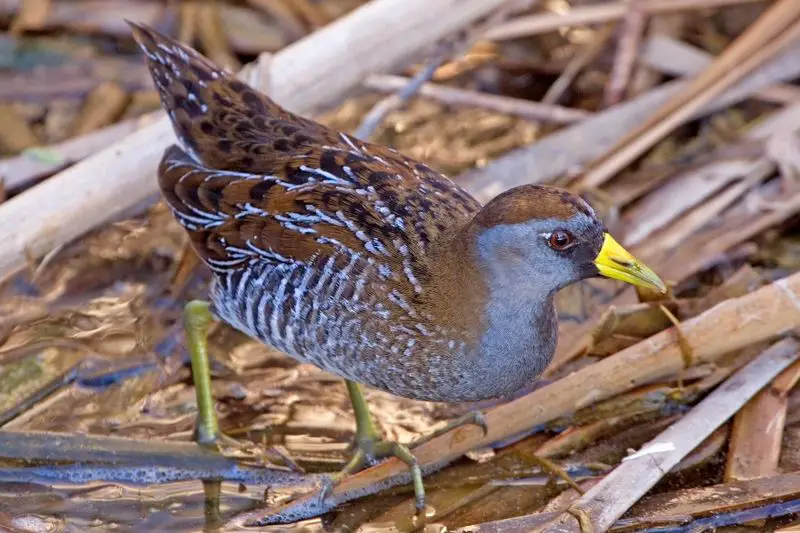
The Sora bird, a member of the rail family Rallidae, can be found throughout much of North America. Its genus name Porzana is derived from Venetian terms for small rails, while its specific name carolina refers to the Carolina Colony.
The common name “Sora” is likely taken from a Native American language. Soras are small waterbirds, sometimes called sora rails or sora crakes. These birds are characterized by their brownish-gray plumage and short, straight bills.
They can be found in marshes, wetlands, and other waterlogged areas, where they typically feed on seeds and insects.
Despite their small size, soras are migratory birds and travel long distances during their seasonal migrations.
Overall, the Sora bird is an interesting and important member of the North American avian community.Scientific classification:
| Kingdom | Animalia |
| Phylum | Chordata |
| Class | Aves |
| Order | Gruiformes |
| Family | Rallidae |
| Genus | Porzana |
| Species | P. carolina |
Also Featured In: Wetlands Birds You Should Know, Small Birds Of Illinois
48. Chachalacas
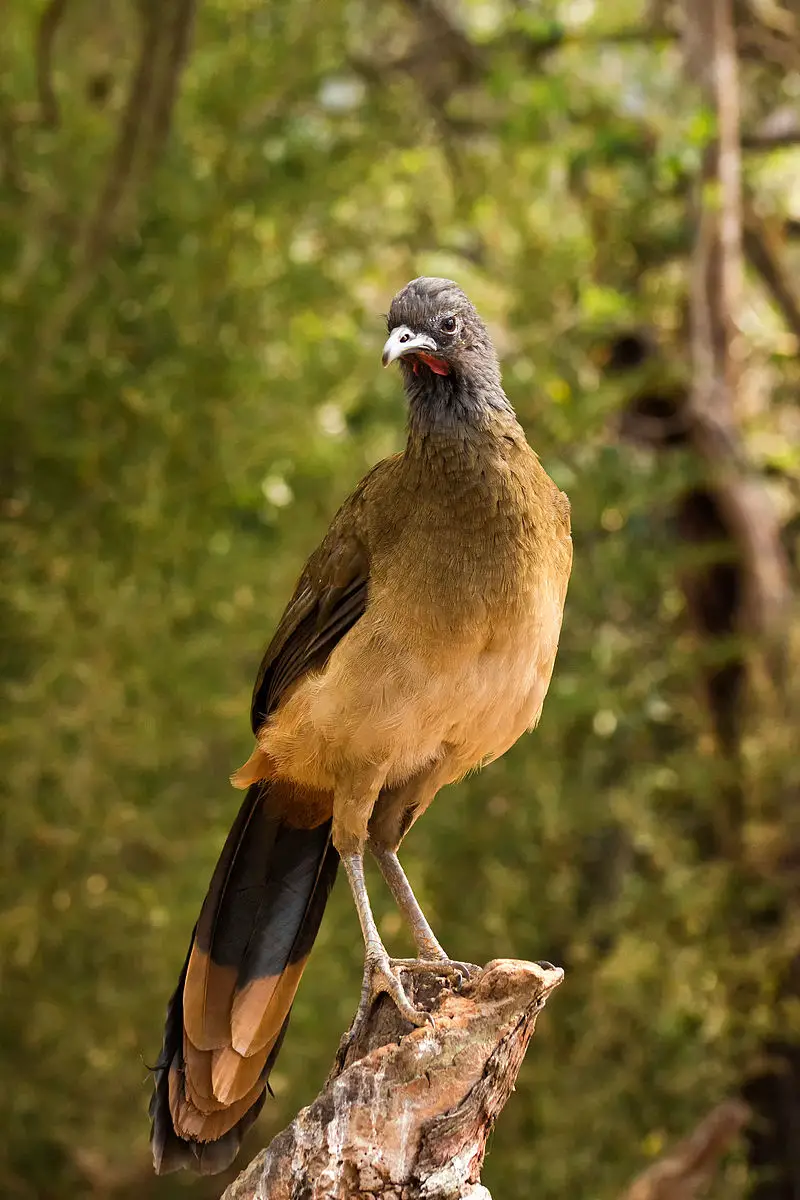
Chachalacas are small-sized galliform birds that are commonly found in wooded habitats across Central and South America, Mexico, and the southern United States, particularly Texas.
Despite being social birds, they are often known for their loud and noisy behavior. Chachalacas have managed to remain fairly common in areas near human settlements due to their small size, which makes them less desirable to hunters.
These birds are not harmful and are not considered dangerous to humans. However, as agricultural pests, chachalacas can cause some problems.Scientific classification:
| Kingdom | Animalia |
| Phylum | Chordata |
| Class | Aves |
| Order | Galliformes |
| Family | Cracidae |
| Subfamily | Cracinae |
| Genus | Ortalis Merrem, 1786 |
Also Featured In: Birds that You’ll Find in Chiapas,
49. Scaled Quail
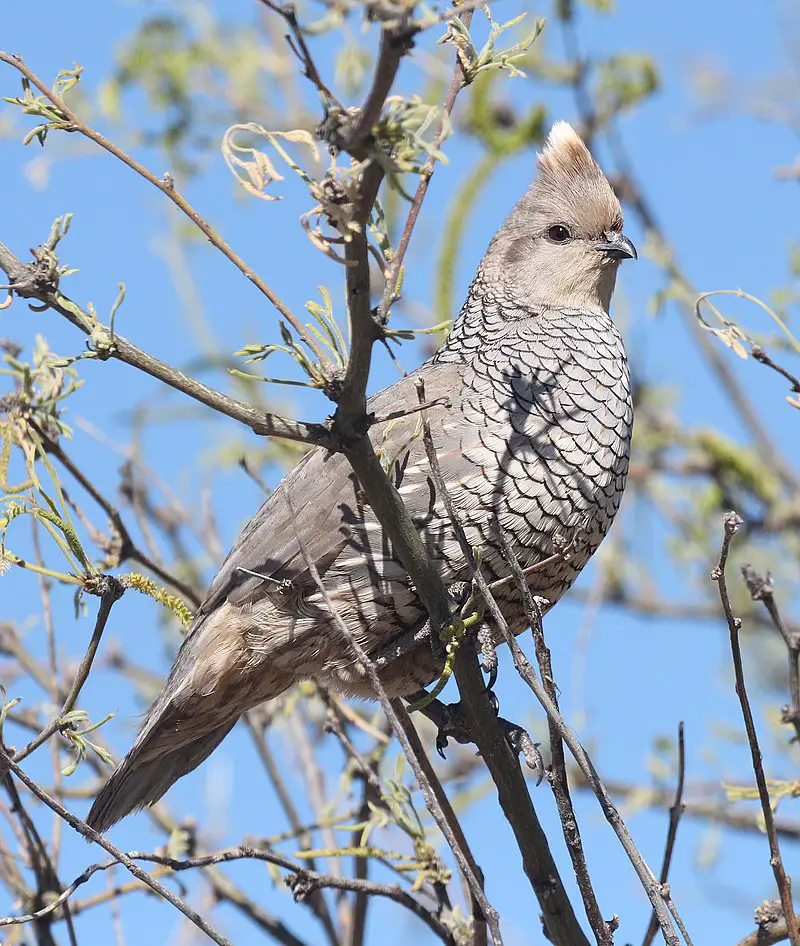
The Scaled quail bird, known as the blue quail or cottontop, is a bluish gray bird found in arid regions of the Southwestern United States to Central Mexico.
It is a member of the New World quail family and an early offshoot of the genus Callipepla that diverged in the Pliocene. The bird’s breast and back feathers have a scaly appearance, which led to its name.
This species is unique in its appearance and is a fascinating addition to the ornithological diversity in the region. Its blue-gray coloration makes it easy to distinguish from other quail species.
The Scaled quail bird is a native bird species in the southwestern United States and is well adapted to surviving in arid conditions.
Its distinct and charming qualities make it a favorite among bird enthusiasts.Scientific classification:
| Kingdom | Animalia |
| Phylum | Chordata |
| Class | Aves |
| Order | Galliformes |
| Family | Odontophoridae |
| Genus | Callipepla |
| Species | C. squamata |